Thirty years into her career as a Foreign Service officer, Kristina Kvien ’87 prepares to transition from Ukraine to Armenia

Curriculum FALL 2 022
Games Tigers Play: Summer Softball and Esports How Oxy Remixed Its Music
Ambassador Extraordinary
OCCIDENTAL COLLEGE
Harry J. Elam, Jr.
President
Wendy F. Sternberg
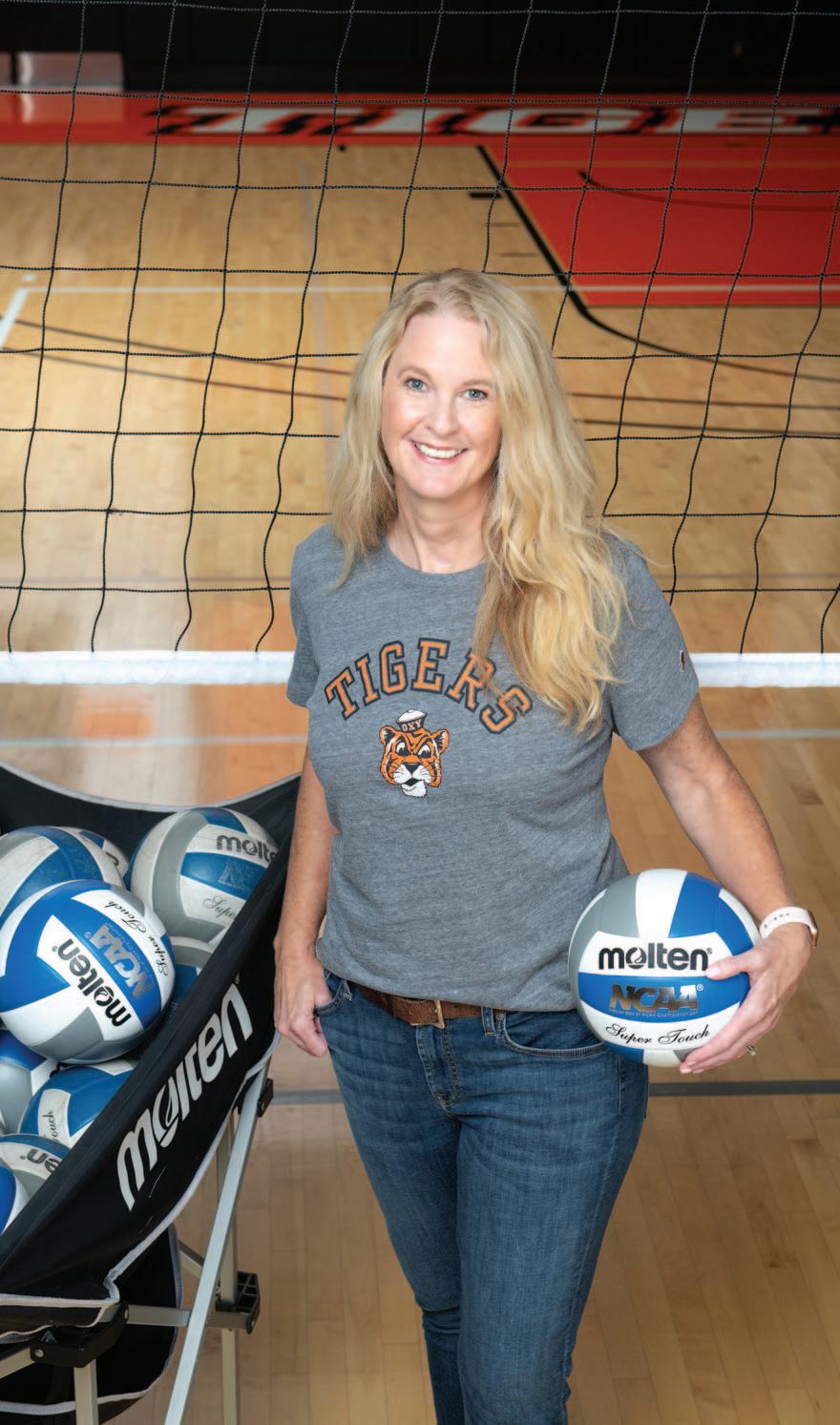
Vice President for Academic Affairs and Dean of the College
Rob Flot
Vice President for Student Affairs and Dean of Students
Charlie Cardillo
Vice President for Institutional Advancement
David T. Carreon Bradley
Vice President for Equity & Justice
Amos Himmelstein
Vice President & Chief Operating Officer Maricela L. Martinez
Vice President of Enrollment James Uhrich Vice President & Chief Information Officer Jim Tranquada
editorial staff Dick Anderson Editor Laura Paisley Contributing Writer Marc Campos College Photographer Gail (Schulman) Ginell ’79 Class Notes Editor SanSoucie Design Design DLS Group Printing
MAGAZINE Published quarterly by Occidental College Main number: 323-259-2500 To contact Occidental magazine By phone: 323-259-2679 By email: oxymag@oxy.edu By mail: Occidental College Office of Communications F-36 1600 Campus Road Los Angeles CA 90041-3314 Letters and class notes submissions may be edited for length, content, and style. Occidental College online Homepage: oxy.edu Facebook:
Instagram:
TikTok: occidentalcollege Twitter: @occidental Cover photo by Dennis Drenner Oxy Wear photo by Marc Campos
44, Number 4 oxy.edu/magazine
crew T-shirt with Tigers lettering over Classic Oswald logo. Sizes
$26.95
College Bookstore oxybookstore.com To order by phone: 323-259-2951 All major credit cards accepted
Director of Communications
OCCIDENTAL
facebook.com/occidental
instagram.com/occidentalcollege
Volume
Women’s
S-XL.
Occidental
Heather Collins Head Coach
Women’s Volleyball
Members of the Class of 2026, photographed on September 10. Top row: Vivian Ko, Ethan Smith, and Paloma Benach.
Middle row: Raymond Arias, Hannah Tawadrous, and Oliver Holoubek-Sebok.
Bottom row: Mikayla “MJ” Jones and transfer student Alex Romanov ’25. 14
Departments
2 First Word
From rebuilding a sense of community to com pleting the Integrated Strategic Plan, President Elam outlines Oxy’s priorities for the new academic year. Also: mixed media offerings.

4 From the Quad

For 26 seasons, Oxy’s Summer Staff Softball League has served up friendly competition for employees and alumni. Also: the impact of water restrictions on campus, and a rankings roundup.
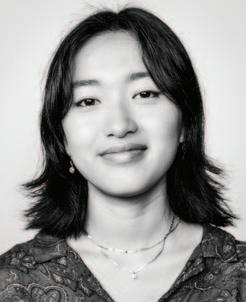
32
OxyTalk
Trustee Lisa Hinchliffe Link P’18 steps up to become board chair— 30 years after her father assumed the same role 36

Tigerwire Class notes for all years.
64
The Art of Diplomacy
Michael Gonzales ’96 embraces his new role as U.S. ambassador to Zambia with intelligence and integrity.

Features
8
Standing With Ukraine

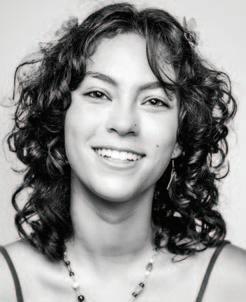

For 2½ years, Kristina Kvien ’87 led U.S. diplomacy efforts inside the embattled and resilient nation— the latest post in a 30-year career with the Foreign Service.



14
First Impressions
Seven members of the Class of 2026 —and a 23-year-old sophomore transfer—open up about their aspirations for their Oxy experience.
20
A Sound Foundation

One of the College’s oldest disciplines, music gets a makeover in response to the production boom of the 21st century—but if you want a classical education, you’ll find that as well. 25
Director’s Cut
Professor/filmmaker Broderick Fox explores the relationship between barbershops and masculinity in his new documentary, Manscaping 28
The Play’s the Thing
With a dedicated space in the Academic Commons, a visionary team of student gamers, and a timely boost from an industry giant, esports levels up at Oxy

FALL 2022
PHOTO CREDITS: Max S. Gerber First Impressions | Don Milici The Play’s the Thing | Marc Campos First Word, From the Quad | Kevin Burke OxyTalk | Michael Gonzales ’96 The Art of Diplomacy
28
» FROM PRESIDENT ELAM
A Purposeful Plan for Occidental
On August 29, the familiar sounds of taiko drumming resounded through the Quad as Oxy held an in-person Convocation cere mony for the first time in three years. While Convocation—the ceremony that marks the official beginning of the aca demic year—is one of our oldest traditions, this year’s event was deliberately designed to return to its original purpose: a gather ing that purposefully includes the entire College community. As we formally wel comed the 534 new members of the Class of 2026 and new transfers from the classes of 2024 and 2025 to cam pus, the joy, excitement and optimism present in Thorne Hall was palpable.
As evidenced by this campuswide opening event, renewing our sense of community—not just for students, but for all of us, including Oxy alumni and parents—after the disruption caused by the pandemic is one of our top priorities for the coming year. Even though we had a full year of in-person activities last year, there remains much we can and will do to develop and maintain an environment in which all students, staff, and faculty know they are welcomed and valued—where they can belong, thrive, and excel.
Rebuilding community is just one of our major objectives for the academic year ahead. My other priorities include: Completing the Integrated Strategic Plan (ISP). Last fall, I initiated the devel opment of a new strategic plan. Ours is an “integrated” plan because it brings the co-curricular, the extracurricular, and the curricular all together and also incorporates our fundamental economic concerns. While Oxy’s mission and its cornerstones of excellence, equity, community, and service will remain, the ISP offers the opportunity to make a new promise to our community and the world as we determine where we want to be as an institution by 2030; what kind of school we want to be; and what strategies we will employ to get
there. During Homecoming and Family Weekend in October, I offered a preview of my vision for Oxy’s future, including the extensive feedback we have received from students, faculty, staff, and alumni over the last year. We intend to present the plan in its final form to the Board of Trustees for its endorsement in April 2023 and start imple mentation in earnest next fall.
Finishing The Oxy Campaign For Good. Having reached our initial campaign
sists of student, staff, faculty, alumni, and trustees, is to develop an overall plan for the College’s climate justice strategy, such as carbon reduction, water resources management, extreme heat resiliency, and environmental justice. The work of OCCRE will help guide our efforts to reach zero emissions by 2050.
Assessment and data-driven decisionmaking. In July, Oxy was reaccredited by the WASC Senior College and University Commission (WSCUC) for another 10 years—the maximum period pos sible. The WSCUC report, as well as the self-study the College performed as part of that process, identified the need to further develop a culture of assessment for all programs at Occi dental: academic, co-curricular, and administrative. Our faculty and staff have done some excellent work in this area. Still, we need to expand and take a more comprehensive evaluative approach to the College as a whole. In this way we will become more institutionally effective with a set of collective matrices and objec tives and a common strategy for evaluating whether we are achieving those goals.


goal one year ahead of schedule, we have an opportunity to build on that momentum and meet some of our most pressing needs. In the coming months, our hope is to con tinue to build on the most successful cam paign in the College’s history by endowing even more student scholarships; financing the much-needed expansion and renova tion of 62-year-old Norris Hall of Chem istry; and enhancing support for students and faculty in our ever-growing Computer Science, Economics, Media Arts and Cul ture, and Music departments.
Initiating the Climate Resiliency and Equity Task Force. The primary goal of the Occidental College Climate Resiliency and Equity (OCCRE) Task Force, which con
As you can see, much exciting work lies ahead. We want to involve the Oxy community as a whole in this process as that is the only way, ultimately, for us to be successful.
I look forward to working with you and visiting with you as I travel to talk with and hear from our Oxy community members across the country. Have a great fall!
2 OCCIDENTAL MAGAZINE FALL 2022 FIRST WORD
President Elam speaks to students in the Quad on Move-In Day, August 23.
Harry J. Elam, Jr.
Photo by Marc Campos
President Elam addresses new and returning students at Convocation on August 29.
» MIXED MEDIA
Ernest Lehman: The Sweet Smell of Suc cess, by Jon Krampner ’74 (Screen Classics). One of the most successful writers in Holly wood, Ernest Lehman (1915-2005) penned some of the most iconic and memorable scenes to ever grace the silver screen. His work on films such as North by Northwest, The King and I, Sabrina, West Side Story, and The Sound of Music helped define a generation of moviemaking. But while his talent took center stage, the public knew little of Lehman him self, a native of Manhattan’s Upper West Side and the Five Towns of Long Island de voted to his wife of 50 years. His relentless perfectionism, hypochondria, and all-night writing sessions fueled by tequila and grilled cheese sandwiches were some of the quirks that made Lehman a legend in the Holly wood community. In this extensive biogra phy, Krampner lays bare the life of this lauded yet elusive character. Moving seam lessly from post-production meetings to sound stages and onto the locations of Lehman’s greatest films, Krampner (Creamy and Crunchy: An Informal History of Peanut Butter, the All-American Food) brings to life the genius and singularity of the revered screenwriter’s personality and the contribu tions he made to the world of cinema.
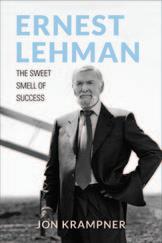
Navigating Media’s Influence Through Childhood and Adolescence: A Question and Answer Guide for Professionals, by Kate S. Kurtin ’06 and Mary Ellen McCormick (Rout ledge). Grounded in developmental theory, mass communication theory, and acumen gained from more than 20 years of combined clinical and teaching experience, this book— written for practicing pediatricians and thera pists—is organized by developmental stage and matches specific questions related to media’s effects with re search-based recom mendations and explanations. Kurtin is associate professor of communication stud ies at Cal State Los Angeles.


Lina’s Song, by Elliot Tuttle ’22 & Rachel Goldfinger ’18 (available on most podcast platforms). In 1980s East Berlin, Lina, a trans femme performer, spends her days preparing for her sets at a local nightclub. During a drug-induced dream, she envisions an opu lent club in West Berlin—and Lina believes it is her purpose to get there, even if it means crossing the Berlin Wall. “I wrote Lina’s Song after moving to Los Angeles from Maine,” says Tuttle, who wrote an early draft as a media arts and culture major in one of Assis tant Professor Aleem Hossain’s screenwrit ing classes. “I was in spired by the difference of queer livelihood and its subversive nature. I had a lot of thoughts about my newfound queer life and queer longing; this story was an exciting way to channel those ideas.” He eventually got the script to executive producer Mark Duplass, who suggested doing Lina’s Song as a fiction podcast, with trans actor Hari Nef attached to star. Fellow MAC alum Goldfinger pro duced the three-episode podcast, working with Tuttle on sound design and editing.
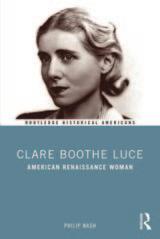


Clare Boothe Luce: American Renais sance Woman, by Philip Nash ’85 (Rout ledge). Wife, mother, author, editor, playwright, political activist, war journalist, congresswoman, ambassador, pundit, and feminist—Clare Boothe Luce (1903-1987) did it all. Carefully placing Luce in a series of shifting historical con texts, this book offers readers an insight into midcentury American political, cultural, gen der, and foreign rela tions history. Eleven primary sources follow the text, including excerpts from Luce’s diary, letters, speeches, and published works. Together, the narrative and documents afford readers a look at Luce with all her complications: Glamorous intel lectual, acid-tongued diplomat, and feminist conservative, she was a deeply flawed highachiever who repeatedly challenged the en trenched sexism of her age to become a significant actor in the rise of the “American Century.” Nash is associate professor of his tory at Penn State Shenango.
Documentaries and Serendipity: America’s Most Dangerous Producer—Surviving Twisted News, Power, Greed and Craziness, by Robert Richter ’50 (available on Amazon). Richter worked on more than 90 documen taries in his career, including primetime tele casts on ABC, CBS, NBC, PBS, and a host of other outlets. A 1988 episode of Nova pro duced by Richter and narrated by Walter Cronkite, “Who Shot President Kennedy?” is regarded by many critics as the definitive doc umentary on the assassination of JFK. Richter was nominated for two Academy Awards for best documentary (short subject) in 1983 and 1995, and his 2007 HBO documentary, White Light/Black Rain: The Destruction of Hiro shima and Nagasaki, won an Emmy Award for nonfiction filmmak ing. “Much of what I have done as a film maker and journalist is … putting a human face on what I believe are vital issues often ignored by mainstream media,” he writes in his memoir. “It is deeply satisfying to know that my work has been seen by millions of people and inspired some to take positive actions because of the truths I presented.” Richter—who graduated from Reed College after attending Oxy—lives in New York City with his wife, Libby.
The Eisenhower Chronicles, by M.B. Zucker ’18 (Historium Press). From leading the forces of liberal democracy against his tory’s most evil tyrant to the presidency, Dwight D. Eisenhower fought for and kept the peace during the most dangerous era in history. The Eisenhower Chronicles dramatizes Ike’s life, portraying his epic journey from un known soldier to global hero in novel form. He is shown working with Franklin D. Roosevelt, Winston Churchill, and Dr. Martin Luther King Jr., and confronting challenges like D-Day, the Little Rock crisis, and Sputnik. Michael Zucker takes readers inside his mind, ground ing the history in the man who made it. A his tory major at Oxy, he earned his J.D. at Case Western Reserve University School of Law. Zucker lives in Arlington, Va., with his wife.
FIRST WORD
FALL 2022 OCCIDENTAL MAGAZINE 3
The Joys of Summer
1. Rick Reinschmidt pitches for the Underdogs. Rick’s sister is Sheryl Reinschmidt ’94, director of financial aid.

2. Los Amigos’ Ryan Terrill, a postdoctoral researcher in Moore Lab of Zoology, tries to elude a tag from Rick Reinschmidt as Under dogs teammate Erik Quezada ’09 looks on. 3. Kelli Hernandez ’08 of Los Amigos makes contact with the ball. 4. Oxy women’s basketball assistant coach Isaiah Flowers, left, and Angel Navarro ’87 lace up for Los Amigos. (All Oxy employees, alumni, and their immediate family members are welcome to play in the league. For more information, contact Courtney Stricklin Burgan ’03 at cstricklin@oxy.edu.)
To the casual softball fan, this contest had it all. There was a keg of beer and a wine-and-beverage selection catered by Dining Services. There was the promise of an epic showdown between two storied franchises: an upstart, patchwork crew (Beer Battered) whose defensive prowess carried them to the title game with upset-minded swagger; and a veteran squad (Los Amigos) who blasted through the season without a loss.

The only thing missing from the Summer Staff Softball League (SSSL) championship was a first aid kit. But when a player for Los Amigos had a tiny cut that briefly stopped the action on August 18, Beer Battered came to their arch-rivals’ rescue with a spare Band-Aid—and the game went on.

That simple adhesive gesture reflects the spirit of SSSL, which typically brings six teams into competition. There’s no trophy at stake, only bragging rights—along with a brightly colored T-shirt emblazoned with the word “Champs.”
Registrar Jim Herr ’86, who served many years as league commissioner, traces the roots of SSSL back to an employee in the Office of Institutional Advancement, who had assem bled a team of Tigers to play in a softball league in Pasadena. Seizing upon the interest that the team generated across campus, he got the seed money from College administrators (to cover the cost of an occasional broken windshield as well) —and Oxy Summer Staff Softball took to Bell Field in 1996.
“Most of our teammates knew each other from working together and interacting from that perspective, but the league gave people an opportunity to interact with other employees across campus whom they wouldn’t ordinarily come into contact with,” Herr says. “At various times, teams would bring food and drink and maybe even cook out after the game —and sometimes they’d invite the other team to join them.”

FROM THE QUAD 4 OCCIDENTAL MAGAZINE FALL 2022
Photos by Marc Campos
2 3 4
For 26 seasons, Oxy’s Summer Staff Softball League has served up friendly competition (and the occasional cold beverage) for employees and alumni 1
Legendary umpire Joe Conte, an Eagle Rock High School alumnus, helped set the tenor for the league. “Joe understood what we were doing there,” Herr says. (Conte died of cancer in 2012.) “While any kind of game is going to be competitive, we didn’t want the competition to dominate, because when you have strong feelings about calls made on the field, things can get a little heated—and we certainly didn’t want that.”


“The competition is there, but it’s at just the right level,” says Michael Garcia ’79, who has played for Los Amigos since the dawn of the league. “We’ve seen our kids grow up playing here,” adds founding teammate Angel Navarro ’87. “It keeps me connected to Oxy.”
In the big game, Beer Battered batted around in the top of the first, stringing together a succession of singles and doubles that added up to a 5-0 lead. Their lead was 6-0 in the





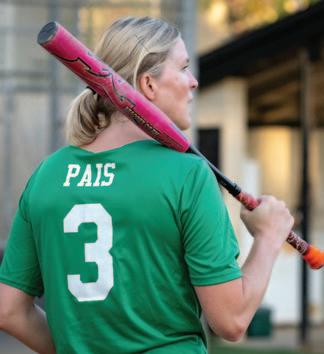

5. Carey Crowell ’07 of Los Amigos. 6. Bell Field has hosted SSSL for all but one season. (Just don’t hit the ball over the right-field fence into the parking lot; that’s an automatic out.)
7. Pitcher Jim Tranquada takes the mound for the Leftovers. 8. Leftovers infielder Laura Paisley awaits her turn at the plate. 9. Amanda RodriguezNewhall of Beer Battered swings away. 10. Mario Markwin bats for the Underdogs. 11. Los Amigos’ Michael Garcia ’79. 12. Beer Battered’s Jesse Kreger ’16 puts the tag on Facilitators’ Miguel Aguilar. 13. Amigos pitcher Freddy Hernandez keeps the ball high.
FROM THE QUAD FALL 2022 OCCIDENTAL MAGAZINE 5
5
8
7
6 9 10 11 13 12
1. Amigos Angel Navarro ’87 and Vantuna research scientist Jonathan Williams field a popup in the title game. 2. Beer Battered’s Culley Johnson swings away as Courtney Stricklin Burgan ’03 (Underdogs) umpires the contest. 3. Kelli Hernandez ’08 snags the ball.





4. High-fives abound after Los Amigos records the final out. 1

4 5 7
third before Los Amigos’ bats came to life. A three-run homer in the bottom of the third put the defending champs on the scoreboard—around the time that the crowd finished off the keg. (“Goals met,” umpire and co-commissioner Courtney Stricklin Burgan ’03 joked between innings.) In the bottom of the fourth, a two-run double and a fielding error evened the score; a couple of hitters later, Los Amigos went ahead, 9-6.

Trailing by five going into the seventh and final inning, Beer Battered made it close—but Los Amigos held on, capping a perfect season with an 13-11 comeback win for their third consecutive title and 12th overall. (For those out there keeping score, Beer Battered [formerly Bat Boys/Athletics] has four titles; Campus Dining and Underdogs, three apiece; Enforcers, two; and Leftovers and Magnetic Fielders, one each.)
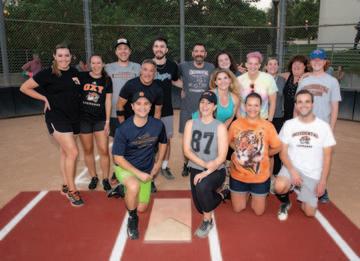
“The league has been a real asset to this campus,” says Los Amigos member and Professor of Sociology Emeritus Mike McAleenan, who hung up his spikes at age 85 after 73 years of organized ball. “Alma has kept the team together amazingly well,” he adds of manager Alma Olmos Garcia ’81, an All-SCIAC basketball player for Oxy. Los Amigos pitcher Freddy Hernan dez, who joined the team about a decade ago after watching wife Kelli ’08 from the bleachers, summed up the SSSL phi losophy before taking the mound: “Whoever wins, wins … I’m out here with these amazing people.”—dick anderson
2 6
3 8 9 10

5. President Harry J. Elam, Jr. takes in his first SSSL game sporting a Dodger-blue jersey, a gift from Oxy Upward Bound. 6. Amigos manager Alma Olmos Garcia ’81 catches up with Janice Fonteno Kolodinski ’81. 7. Los Amigos are all smiles after their threepeat. 8. Runners-up Beer Battered came on strong late in the season. 9. Co-commissioner Williams hugs Amigos teammate Mike McAleenan, professor emeri tus of sociology. 10. Troy Hernan dez high-fives his dad, Freddy, after he crosses home plate for Los Amigos. (Mom Kelli ’08 played softball for the Tigers.)

6 OCCIDENTAL MAGAZINE FALL 2022 FROM THE QUAD
Changes to the Landscape
campus
Occidental reduced its water usage by more than 2.9 million gallons over the summer in re sponse to California’s prolonged drought with a variety of methods, allowing some campus lawns to turn brown while increasing drought-tolerant landscaping and improving its data gathering.


The Metropolitan Water District of Southern California, which supplies much of the region’s water, declared a water shortage emergency in April and ordered local water agencies to reduce their water usage by a third. Oxy’s supplier, the Los Angeles Department of Water and Power, im posed new water use restrictions effective June 1.
“Oxy is committed to doing our part to con serve water and is complying with all regula tions,” says David Caldwell, director of facilities. “Beginning in May the College began a systemwide review of water usage across campus, focusing on reducing water use for outdoor irrigation.” This summer’s reduction amounts to about a third of the College’s normal water use, he adds.
While some lawns are being replaced with decomposed granite (most noticeably at Mullin Entrance) and other areas re-landscaped with plants that use less water (Sycamore Glen), other lawns have been allowed to turn brown (the upper soccer field and outside Newcomb Hall, for exam ple). High-use lawns, like those in the Quad, are still green, but in some cases are being replaced
with grass varieties that require up to one-third less water. Sprinklers are being replaced with more efficient drip irrigation systems.
To better track water use across campus, Facil ities is installing new submeters in each campus building to more effectively monitor water usage and establish an accurate baseline measure. With students back on campus this fall, the College also will be exploring new ways to save water in residence halls. Domestic water use while classes are in session outweighs outdoor use, Caldwell notes—so, while green lawns may be in short supply at the moment, students are still encour aged to shower regularly.
worth noting
Oxy once again ranks highly among the nation’s top liberal arts colleges, according to the 2022-23 editions of major college guides.
Occidental places No. 37 in U.S. News & World Report’s annual rankings, and appears on its “best value,” “most diverse,” “most innovative,” “best under graduate teaching,” and “top per formers on social mobility” lists.
Oxy receives four-star rat ings for academics and quality of life from the Fiske Guide to Colleges, and ratings of 89 for academics and 97 for financial aid in Princeton Review’s The Best 388 Colleges. The Wall Street Journal/Times Higher Education rankings listed Oxy No. 34 among U.S. liberal arts colleges; Forbes ranked Oxy at No. 29.
Occidental also appears in the top college lists compiled by Money (No. 37 among liberal arts colleges), Washington Monthly (No. 43) and Niche (No. 40). Payscale’s 2021-22 College Salary Report places Oxy at No. 25 among liberal arts colleges with the highest-paid alumni.
Oxy’s Music Department was named to Billboard’s list of the world’s 38 top music busi ness programs—one of only three liberal arts colleges to be so recognized (page 14).
Professor of Linguistics and Archeology
Emerita Elizabeth “Betchen” Barber was honored with the 2022 George Hewitt Myers Award for lifetime achievements in textile arts by the George Washington Mu seum and the Textile Museum on November 3. In a virtual cer emony, Barber reflected on her research on the origins and his tory of textiles across Eurasia and Europe, including the role and innovations of women.
FALL 2022 OCCIDENTAL MAGAZINE 7 FROM THE QUAD
In response to California’s prolonged drought, the College reduces its water usage on
Replacing Taylor Pool and hearkening back to architect Myron Hunt’s original plan, Cannon Plaza (named for trustee and lead donor Anne Wilson Cannon ’74) creates a reimagined gathering space for the Occidental community. In keeping with the College’s practice of renovating and repurposing its historic buildings, the plaza, left, preserves the colonnaded E.S. Field Building, while filling and converting Taylor Pool into a courtyard and garden for outdoor gatherings.
Working with Physics Professor Daniel Snowden-Ifft, Cole Lewis ’23 (above), a physics major from Seattle, collects rainwater from Stearns Hall for use in watering nearby plants, which offsets the water used to clean Occidental’s solar array. (ARCCS stands for A Rain water Collection and Cleaning System.)
Photo by Marc Campos
Photo courtesy Architectural Resources Group
For 2½ years, Kristina Kvien ’87 led U.S. diplomacy efforts inside the embattled and resilient nation— her latest post in a 30-year career with the Foreign Service


 By STEVEN BOYD SAUM | Photo by DENNIS DRENNER
By STEVEN BOYD SAUM | Photo by DENNIS DRENNER
Standing With
UKRAINE UKRAINE
he New Year began with alarm bells ringing for Kristina Kvien ’87, the United States’ top diplomat in Ukraine. As chargé d’affaires—a position she had held since January 2020— she was working with colleagues to lead the on-the-ground U.S. response to what was looking increasingly like an imminent Russian invasion. Russian President Vladimir Putin had been doubling down on rhetoric that denied the right of Ukraine (which became an independent nation in 1991) to even exist—a notion hard to square with the idea that he might be looking for an off-ramp to war. Yet, as part of the U.S. strategy, Kvien and others tried to keep an exit in place— even as they publicly and pointedly called out false flags that intelligence indicated were in the works.

For its part, Ukraine’s government down played warnings as overly alarmist, as Presi dent Volodymyr Zelensky sought to maintain calm in the country. Before the end of January, all family members of the approximately 180 U.S. employees at the embassy in Kyiv were
Snapshots from Ukraine, 2022—top: Back in Kyiv on May 8, Victory in Europe Day. left: Kvien and Ukrain ian Football Association head Andriy Pavelko, center left, sport a “United for Ukraine” jersey designed by the Ukrainian national team. bottom left: Meeting with Minister of Interior Denys Monasterskyy to discuss U.S.Ukraine relations on May 11. bottom right: Speaking in L’viv on May 2, after return ing to Ukraine for the first time since the war began.

8 OCCIDENTAL MAGAZINE FALL 2022
Photos (unless noted) from U.S. Embassy Kyiv Ukraine Facebook page
ordered to leave the country out of an abun dance of caution. As planeloads of defense assistance from the United States were ar riving in Kyiv, Kvien made it clear that any Russian invasion would not be easy for the aggressors. “Let me underscore that Russian soldiers sent to Ukraine at the behest of the Kremlin will face fierce resistance,” she said at a press conference on January 25. “Losses to Russia will be heavy.”
By mid-February, Kvien and the remain ing core embassy staff departed the five-story office building in Kyiv and set up temporary headquarters some 336 miles to the west in L’viv, in western Ukraine. One hundred and
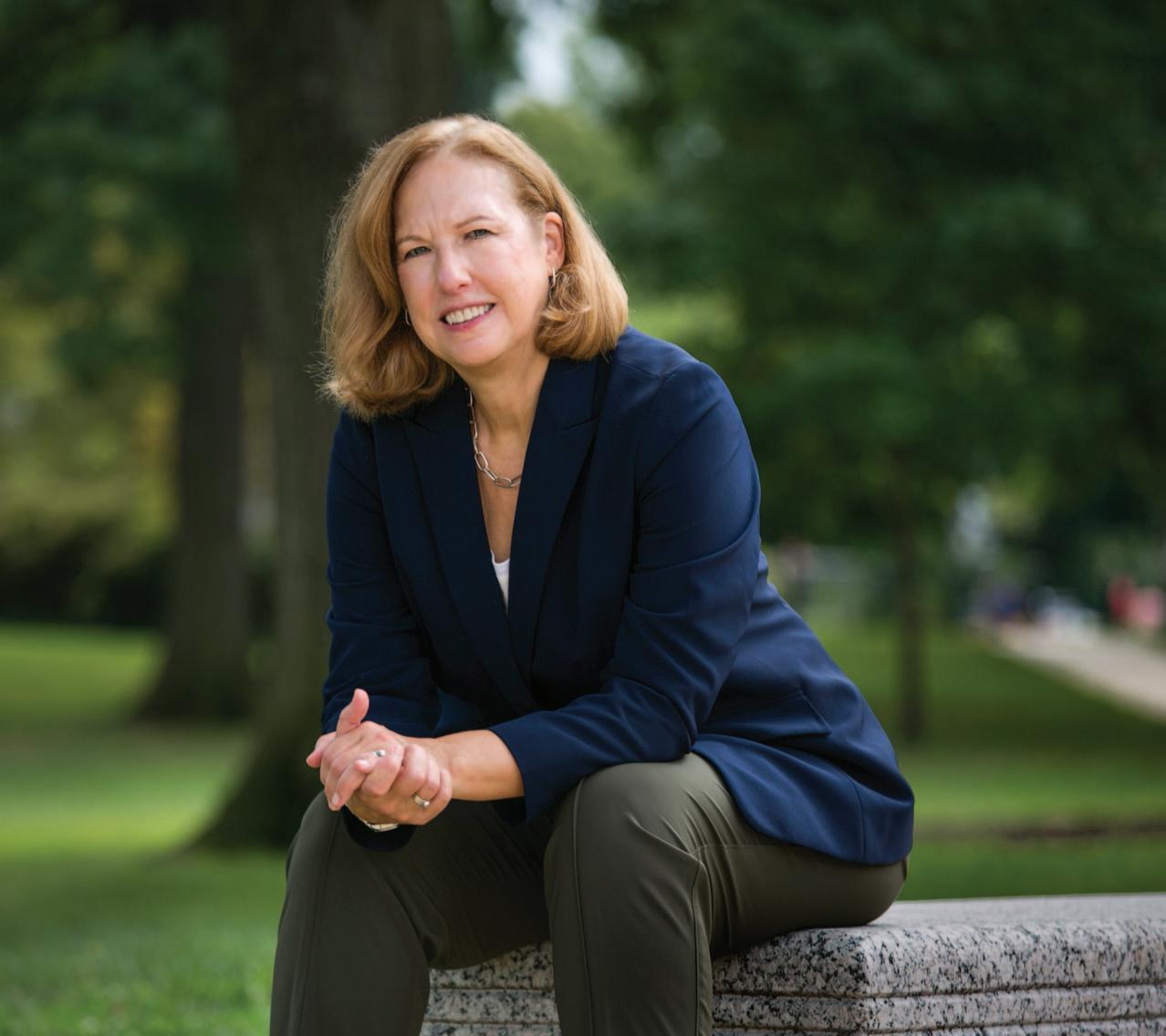

fifty thousand Russian troops were massed on Ukraine’s borders, even as the Kremlin claimed that it was drawing down. “Frankly, President Putin lies, and he’s done it before,” Kvien told NPR. “He’s doing it now. … His suggestion that somehow they’re pulling back is simply false.”
On February 21, Putin delivered a speech denying once again that Ukraine had even a tradition of statehood, portending an immi nent Russian invasion. In a press conference in L’viv, Kvien responded by calling Putin’s comments about Ukraine “delusional” and pledging “a forceful response from the United States, our allies and partners.”
FALL 2022 OCCIDENTAL MAGAZINE 9
Kristina Kvien ’87, nominee for U.S. ambassador to Armenia, photographed in Washington, D.C., on September 12.
That night, Kvien and her team moved across the border to Poland and set up U.S. operations in a hotel in the city of Rzeszów. Then, early on the morning of February 24, Russian rockets were launched at targets across Ukraine and tanks rolled across the border as Russia began an unprovoked war of aggression of a scale Europe hadn’t wit nessed since the end of World War II.
In announcing the so-called special mil itary operation, Putin warned against Amer ican interference, saying it would bring a response “unlike any you have seen in your history.” For Kvien and her colleagues state side, the goal was to help Ukraine without starting World War III.
The national anthem of Ukraine is “Ukraine Has Not Perished Yet.” By the end of March, that had taken on new resonance. The Russian plan to take Kyiv within days and decapitate Ukraine’s government had failed. Ukrainian troops began liberating towns near Kyiv, including Bucha and Irpin—bucolic bedroom communities that had been home to young families, as well as Ukrainian staff at the U.S. Embassy and Ukraine’s ambassador to the United States, Oksana Markarova. Russian forces left behind a trail of devastation and slaughter—proof, Kvien told CNN, that “President Putin is a butcher.”
Virtually everyone in Ukraine—includ ing Kvien—knows someone who has been wounded or killed in the war. At the end of April, it was announced that one of those killed in the fighting in the east was her per sonal bodyguard, Volodya; the embassy used only his first name to protect his family. He had served Kvien for two years and took a

leave of absence when the war began to re join the army and defend Ukraine. Thanks to the fierce defense by Ukraine’s forces, “Rus sia’s already lost,” she told NPR, “certainly if you judge it by what their initial objec tives were.”
On May 2, Kvien returned to Ukraine. “We are thrilled to be back!” she said at a press conference in L’viv, and expressed hopes that the embassy would reopen in Kyiv by month’s end. “Today, it is clear that Putin has made a historic miscalculation in his unprovoked and unjustified attack on Ukraine,” she said. “Ukrainians have shown the world what true heroism is—from the border guards at Snake Island who told a Russian warship what it could do to itself, to Azov regiment’s fearless defense of Mariupol, to President Zelensky and the entire Ukrain ian government working throughout attacks on Kyiv while brave defenders defeated ap proaching Russian forces.”
On May 8, Kvien led a team of senior diplomats back to the U.S. Embassy on Igor Sikorsky Street in Kyiv. She met with top officials, including Foreign Minister Dmytro Kuleba, Presidential Chief of Staff Andrii Yermak, Deputy Prime Minister Iryna Veresh chuk, and Kyiv Mayor Vitali Klitschko. “De lighted to be back on Victory in Europe Day,” the embassy posted on social media. “Slava Ukraini! We stand with Ukraine.”

After the embassy reopened, Kvien jour neyed to Borodyanka, northwest of Kyiv, to bear witness to the horrors wrought by Russian invaders there. Home to some 14,000 people before the war, Borodyanka was now, in the words of Ukrainian journal ist Olena Makarenko, “nightmarish carcasses
of the apartment blocks hit by Russian bombs, rockets, and shells.” Hundreds of civilians likely died in artillery strikes. In the small park stood a monument to poet Taras Shevchenko—the statue’s forehead now riddled with bullet holes.
Growing up in Fresno, Kvien was fascinated with politics and government by the time she got to high school. International travel was not part of her upbringing, though her mother was a travel agent. While her politi cal science major at Oxy didn’t require a de clared concentration, in practice she found one, thanks to Larry Caldwell, the Cecil H. and Louise Gamble Professor in Political Sci ence Emeritus. Kvien took Caldwell’s year long Soviet studies course, as well as other courses focused on the Soviet Union or East ern Europe. “I really enjoyed [Caldwell] as a professor, and I was intrigued by the sub ject,” she says.
As an expert on Soviet foreign and mili tary policies, arms control, and U.S. national security policy, Caldwell also brought to the classroom experience testifying before congressional committees and advising pres idential campaigns. He served as a scholarin-residence at the CIA and a research associate at the International Institute of Strategic Studies in London. For Kvien and generations of Oxy students, he delivered a front-row seat to history being made.
In 1985, Mikhail Gorbachev was elected general secretary of the Soviet Union and soon embarked on a series of historic reforms. During Kvien’s senior year, Gorbachev and President Ronald Reagan met in Reykjavík, Iceland, inaugurating sweeping efforts to
10 OCCIDENTAL MAGAZINE FALL 2022
below: Kvien reaffirms the United States’ commit ment to Ukraine while speaking at the World in 2022 Forum on December 21, 2021. right: Enjoying a brief reunion with Denise Campbell Bauer ’86, right, the U.S. ambassador to France, in late March.
Photo courtesy Denise Campbell Bauer ’86 via Twitter
reduce the threat of nuclear weapons—a turning point in the Cold War.
Kvien’s studies at Oxy sparked such an interest in working as a diplomat that she took the Foreign Service exam her senior year—passing the written portion but not the oral tests. After graduation, she tried again and passed both. “Oxy is pretty good at inculcating resilience,” Kvien says. “If I had quit after the first time, I wouldn’t have made it in.”
She joined the Foreign Service in 1992, when new embassies were opening in coun tries that had formerly been part of the USSR. “It was a momentous time in interna tional relations,” Kvien says. “It was a period of a lot of optimism”—in which idealism and a sense of being a part of history put a luster on government service.
Kvien studied French at Oxy, which proved useful for her first assignment, in Paris. Foreign service officers typically focus on one area of expertise—for instance, polit ical, economic, or consular. Kvien opted for the economic track and arrived in Europe shortly after the signing of the Maastricht Treaty, which paved the way for a single cur rency and the formal creation of the European Union in 1993. Post-communist economies to the east also were being transformed.
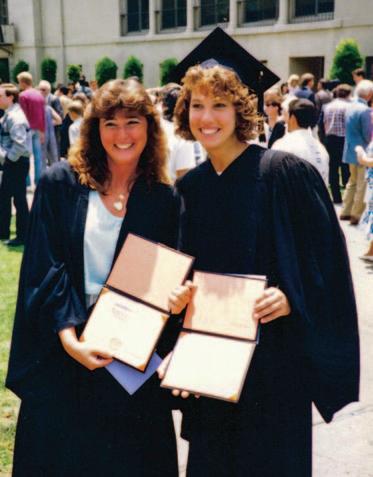
Her next assignments took Kvien to the Philippines and then back to Washington, D.C., tackling EU and Organisation for Eco nomic Co-operation and Development issues. She worked as a desk officer on Slovenia. She served in Brussels and then Moscow, respon sible for environment and trade issues. She added Russian to her languages. Detailed to the National Security Council, she worked with a portfolio that encompassed Ukraine, Belarus, and the European Union. She served in London overseeing U.S.-U.K. economic relations and served as economic counselor and acting deputy chief of mission in Bangkok, Thailand. When she arrived in Ukraine in 2019, she was coming from an assignment as economic minister counselor and acting deputy chief of mission—DCM in foreignservice speak—in Paris.
Prior to Ukraine, Kvien had never served in a war zone. But she knows well how economics and energy are bound up in global security. This year, implementing and main taining sanctions by the U.S. and EU against Russia have been absolutely critical to Ukraine’s survival. In that work, she has sup
port from Denise Campbell Bauer ’86, the U.S. ambassador to France. In late March, Kvien’s work took her to Paris, which offered the chance for a brief reunion with her fellow Tiger. The two “shared the same benches at @Occidental,” Bauer posted on Twitter. “#SolidaritéUkraine.”
In spring 2019, Ukraine transfixed the world with its presidential elections as Zelensky, a former comedian turned media entrepreneur and executive, was swept into office with 73 percent of the vote. The elec tion was “competitive and held with respect for fundamental freedoms,” the Organiza tion for Security and Cooperation in Europe assessed. “The orderly transfer of power should offer the opportunity for strengthen ing democratic institutions and their ac countability.”
Days later, then-U.S. Ambassador to Ukraine Maria Yovanovitch was recalled to Washington—two months before she was scheduled to finish her assignment. (Details of behind-the-scenes efforts to undermine her would figure into the first impeachment of President Trump in 2020.)
Soon after that, Kvien arrived in Kyiv as part of the U.S. mission. She was no stranger to the city: While serving on the National Se curity Council from 2008 to 2010, she visited Ukraine twice. William Taylor, ambassador to Ukraine from 2006 to 2009, returned to serve as chargé d’affaires in June 2020. Kvien
assumed the role of DCM, overseeing the in ternal functions of the embassy. As a career foreign service officer, “I really try to avoid politics,” she says.
Kvien’s husband joined her in Kyiv, as did their 14-year-old Moscow street cat, Snickers. (Daughter Hanna White ’20, then a rising senior at Oxy, lived with them and worked for the embassy during that first summer as well; she is now a teacher in Washington, D.C.)

In January 2020, Taylor left Kyiv, and Kvien took over as chargé d’affaires. Before the war, U.S. priorities included working with the Ukrainian government to reduce corruption, stabilize energy consumption and development, and rein in oligarchs to show that they were not above the law. Judi cial reform was one prominent example, and building buy-in with Ukrainian leaders was key. “Ultimately, we succeeded because President Zelensky became convinced that Ukraine needed judicial reform,” Kvien says. “Without him saying, ‘You’ve got to get this done, this is my current priority,’ it would not have been able to happen.
“Until the war started, they were making progress, and I think that’s ultimately what will lead them to meeting EU requirements for membership and to having a more vibrant economy,” she adds. Kvien points to the 2019 elections in Ukraine and the suc cessful democratic transition—something Russians have not had in this century. There
FALL 2022 OCCIDENTAL MAGAZINE 11
above left: Kvien as a student at Bell-Young. above right: Kvien, right, and lifelong friend Harriet Schwartzman ’87 flash their diplomas following Commencement.
Photos courtesy Harriet Schwartzman ’87
below: Kvien meets with U.S. Secretary of State Antony Blinken in Rzeszów, Poland, on March 5. right: Kvien with U.S. Ambassador to Ukraine Bridget A. Brink on May 30. The two career diplomats have known each other for 15 years.
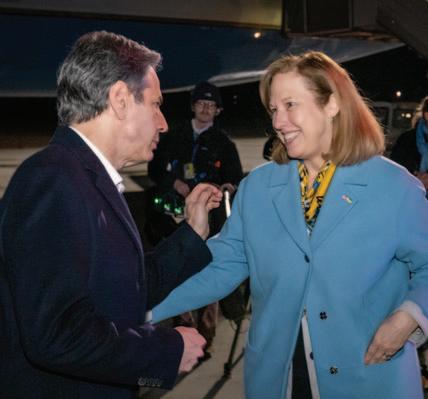
Blinken photo by Ron Przysucha/State Department
is a vibrant NGO sector and a thriving free press—including outlets that, prior to the war, were unabashedly critical of the Ukrain ian government.
Kvien led the embassy through the COVID-19 pandemic, which has claimed more than 100,000 lives in Ukraine and severely curtailed travel. In February 2021, she got her first glimpse of the war that Rus sia had brought to Ukraine’s Donbas region in 2014. With Zelensky and several other diplomats, she traveled to Avdiivka on the so-called line of contact. They saw the dev astation and witnessed what in theory was a ceasefire in which Russian-backed forces used snipers, mortars, and artillery to attempt to provoke Ukrainian troops to respond. Since April 2022, Avdiivka has seen fierce fighting again, after Russian troops began a push; as of September, Ukrainian forces still hold there.
As a diplomat, Kvien comes across as downto-earth and plain-spoken. While she served as top U.S. diplomat in Ukraine for 2½ years, she managed to lead without the title of am bassador. At the beginning of 2022, President Joe Biden had yet to formally nominate any one for that post. Talking to Politico in Janu ary, former U.S. Ambassador to Ukraine Stephen Pifer remarked that Kvien “is doing a superb job. … Why not nominate her?” For
mer ambassador William Taylor “enthusias tically agreed,” the website reported.
On April 25, the White House announced that it would nominate Bridget Brink, U.S. ambassador to Slovakia since 2019, to the Ukraine post. Asked by NPR what advice she would give Brink—whom she has known for 15 years—Kvien replied with a laugh: “Rest up and get lots of sleep.” Brink knows Ukraine and the region, she noted. “She can just step right in and be fully effective on the first day.”

The Senate quickly confirmed Brink, who arrived in Kyiv on May 30, bringing Kvien’s assignment in Ukraine to an end. As gratitude for her support and solidarity, Zelensky pre sented Kvien with Ukraine’s Order of Merit.
It had been 99 days since Russia launched a full-scale invasion and began a war whose consequences will extend far beyond the boundaries of Ukraine. Russia had invaded Georgia in 2008, and Crimea and Donbas six years later. “Putin has been pretty clear in some of his more recent statements about how he really sees things—that all of the former Soviet Union should be Russian,” Kvien cautions. “That includes some NATO members.”
Shortly after Kvien returned to Washing ton, D.C., Biden nominated her to serve as U.S. ambassador to Armenia on July 11. (Kvien’s hometown, Fresno, has long been home to a large and active Armenian com munity.) If confirmed by the Senate, this will be her first post with the title of ambassador.
Armenia shares borders with Iran, Turkey, Georgia, and, most significantly, with Azer baijan, with which there has been a long-sim mering conflict over the Nagorno-Karabakh region. Along with efforts to pursue a lasting political solution to the conflict, U.S. priori ties include strengthening democratic insti tutions and fostering “sustainable and inclusive economic growth.”
Speaking just before Ukraine Independ ence Day in August, Kvien hailed the bravery, fortitude, and resilience the Ukrainian peo ple have shown in fighting to maintain their independence. For the last several decades, the country has been trying repeatedly to break free of Russian control and influ ence—and had essentially succeeded.
“That is why I think, ultimately, Russia made the decision” to invade Ukraine, Kvien says. Putin’s playbook called for false flags, dividing allies, spinning absurd lies, and working assumptions that what Russia was saying and Ukraine was saying might both be partially right, and somehow the truth lay somewhere in the middle. “In this particular conflict, there is definitely no middle truth,” Kvien says. “There is one truth, and the truth is Russia invaded Ukraine with no provoca tion and no international legal justification.”
During the war in 2022, the city of Mariupol has become synonymous with Russian cru elty and destruction. In June 2021, Kvien saw it in its summer seaside splendor; she had traveled there and to the southern port city of Berdyansk to visit a border guard station supported by a State Department program.
Kvien looks forward to a time when Ukraine’s main focus can be meeting the EU objectives “and not having to fight a war with Russia. Ukraine is striving to join the com munity of democracies that work together to make a better world and make a better envi ronment for their own people in their home countries,” she says. “Ukraine has the weight of history on its side.”
Beyond the devastation of the current war, there are the deeply troubling implica tions of a world where, if Russia succeeds, global relations are reduced to “might makes right.” “A new series of threats have arisen, not just authoritarianism,” Kvien cautions. “Environmental threats have become more serious in the last 30 years. When we see drought, this leads to food insecurity and famine.”
And yet, she says, “As optimistic as I was in 1992 when I joined the State Department, I’m not un-optimistic now. You have to con tinue to solve the challenges and threats that are put in front of you.”
Steven Boyd Saum is the editor of World View magazine. He served with the Peace Corps and led the Fulbright program in Ukraine, where he also has served as an election observer.
12 OCCIDENTAL MAGAZINE FALL 2022
DIPLOMATIC COMMUNITY
At the suggestion of a professor of labor relations at Oxy, U. Alexis Johnson ’31 wrote to Washington, D.C., as a senior for infor mation on the U.S. Foreign Service, which in 1924 merged the nation’s diplomatic and consular services into a single organization. Several months after graduation, he drove to Washington in his Ford Model A, enrolling in the Foreign Service School at Georgetown in preparation for the Foreign Service exam.
Johnson passed the exam and became a career diplomat, leading to a succession of posts as U.S. ambassador to Czechoslovakia (1953 -1958), Thailand (1958-1961), and Japan (1966 -1969). From 1964 to 1965, he was deputy ambassador to the Republic of Vietnam. “I have found that what I learned at Occidental has stood me in very good stead for a Foreign Service officer,” Johnson wrote in his 1984 memoir, The Right Hand of Power. “There are a lot of hard factual matters important in international affairs— foreign trade, banking laws, tariffs, interna tional exchange, and arbitrage—that one cannot easily pick up on the job but must learn through study.”
Johnson’s classmate and College debate partner, Toshiro Shimanouchi ’31, entered the Japanese Foreign Service following WWII, serving a succession of prime minis ters as their English translator on official vis its to the United States and United Nations and finishing out his career as Japanese ambassador to Norway. “From all my expe riences, I have learned how basic and vital is the function of communication between nations and peoples,” he said at Oxy’s Com mencement in 1981. “Without an adequate flow of information in balanced perspective, there cannot be adequate and meaningful mutual understanding.”
A member of the Foreign Service since 1951, Harvey F. Nelson Jr. ’47 was nomi nated by President Ronald Reagan to serve as U.S. ambassador to Swaziland (Eswatini) in 1985—a post he would hold until 1988.
far left: Denise Campbell Bauer ’86 and Daniel Lacy ’78, vice president of the American Club of the Riviera, met in Nice in September. left: Toshiro Shimanouchi ’31, second from left, translates for Japan ese Prime Minister Hayato Ikeda, left, at a meeting with Presi dent John F. Kennedy on June 20, 1961.

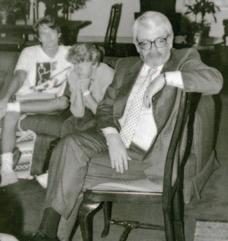

above left: David Aaron ’60 delivers a public policy seminar at Oxy in 1983. above right: Deputy Ambassador U. Alexis Johnson ’31, left, evacuates the U.S. Embassy in Saigon on March 31, 1965, after a car bomb parked outside the building killed 22—19 Vietnamese, two Americans, and one Filipino.
Raymond C. Ewing ’57 entered the For eign Service soon after his 21st birthday and would serve decades later as U.S. ambas sador to Cyprus (1981-1984) and Ghana (1989 1992). His history major at Oxy made a “tremendous” impact on his career, “espe cially courses on modern Europe with John Rodes, modern Asia with P.K. Mak, and international relations with Ray McKelvey,” he wrote in 2002.
In 1979, Time chose David Aaron ’60 as one of “50 Faces for America’s Future.” He was lauded for his service as a diplomat, his expertise on arms control, and his role in the SALT II negotiations (he served as President Jimmy Carter’s deputy assistant for national security affairs from 1977 to 1981). In 1993, Aaron was named U.S. ambassador to the Organization for Economic Cooperation and Development, a position he held until 1997.
A native of Johannesburg, South Africa, Aggrey Mbere ’69 spent most of his adult hood living in exile in America, frequently speaking on the anti-apartheid struggle back home. After returning to South Africa, he was appointed as the country’s ambassador to Rwanda in 2001. Mbere died two years later at age 64. At his memorial service, Deputy Foreign Minister Aziz Pahad hailed Mbere as “an outstanding patriot whose
whole life was unconditionally and totally dedicated to the struggle of the people.”
Before entering the Foreign Service in 1978, David Dunn ’71 worked for the City of Escondido. Since 1988, his focus has been Africa, with overseas assignments in five countries prior to his appointment as U.S. ambassador to Zambia (1999 -2002)—a post now held by Michael Gonzales ’96 (page 64). Dunn also served as U.S. ambassador to Togo (2005-2008). He retired from the Foreign Service in 2010.
William Bellamy ’72 capped a 30-year Foreign Service career as U.S. ambassador to Kenya from 2003 to 2006, where he directed U.S. security programs in the Horn of Africa, supervised the government’s largest foreign HIV/AIDS program, and led a multinational effort to promote good governance.
Appointed by President Barack Obama ’83 as U.S. ambassador to Belgium in August 2013, Denise (Campbell) Bauer ’86 focused on transatlantic security partnerships and international trade. Upon returning from Brussels in 2017, she re-engaged in politics, focusing on supporting women running for office for the first time. Last December, Bauer was sworn in as U.S. ambassador to France and Monaco—and her small rescue dog, Daisy, sometimes joins her at work.

FALL 2022 OCCIDENTAL MAGAZINE 13
Photo credits: Daniel Lacy ’78 (Bauer), JFK Library (Shimanouchi), Frances Hill (Aaron), Francois Sully (Johnson)
Fir IMPRESSIONS
Seven members of the Class of 2026 —and a 23-year-old sophomore transfer— open up about their aspirations for their Oxy experience
By ANDY FAUGHT Photos by MAX S. GERBER
Hannah Tawadrous
A week into the fall semester, Hannah Tawadrous eagerly checked out Occidental’s Involvement Fair, signing up for a number of groups that sparked her interest. A Coptic Egyptian—the largest Christian group in the predominantly Muslim country—Hannah says being part of Oxy’s Middle Eastern Club is vital to her college experience.
“I was talking to the girl at the booth in the Quad, and I realized that we were both Coptic Egyptians,” says Hannah, who led a Middle East/North African affinity group at the Urban School of San Fran cisco, sharing her family’s tabbouleh recipe with students, faculty, and staff at a party last spring. “What are the chances? So, I already feel connected to people, which has been super great.”
Community is embedded in Hannah’s DNA. In 2016, she and a group of friends started the Noe Valley Girls Film Festival to give young female filmmakers a venue to screen their own shorts. (Her film, Pinky Spinky Perfume, was a finalist in the grades 6-8 division.) The festival attracted the notice of the San Francisco Chronicle and continues to this day.
Hannah was drawn to Occidental for its diversity—both ethnically and for the range of experiences she hopes to have: “I’m very excited to hopefully get good at ultimate Frisbee. I’ve never played before.”
She’s also wide-eyed about getting a job at the Tiger Cooler. “I’ll be the friendly person behind the counter making people drinks,” she says with a laugh. “I like the idea of being in a communal place where everybody is.”
For now, Hannah is going to drink up her college experience. “I’m undeclared, and I actually have no idea what I want to do. But that makes it kind of fun.”

14 OCCIDENTAL MAGAZINE FALL 2022
Raymond Aas

Midway during Raymond Arias’ freshman year of high school in Tualatin, Ore., his dad—who lived in California —was deported to Mexico because he was undocu mented. It was only after the pandemic began that Ray mond fully processed his emotions. “Both my mom and stepdad were having to work a lot more to keep us afloat,” he explains. “I was acting as a caretaker for my younger brother and my cousin, and the rigor of this re sponsibility showed me what it means to care for some one beyond yourself. It made me more empathetic and taught me a lot of resilience.”
Following high school, Raymond took a gap year, dur ing which time he had an internship with the Coalition of Oregon School Administrators in developing legislative measures that sought to improve Oregon’s public schools. The experience sparked his interest in policy making, says Raymond, who previously served as presi dent of the Oregon Association of Student Councils,
which represents more than 120 schools statewide. It also gave him the chance to cultivate interpersonal and leadership skills.
Raymond enrolled at Oxy because it’s the “perfect place for me to grow academically and personally.” He’s planning to major in economics, with hopes of pursuing a legal career in the area of civil rights, corporate law, or intellectual property.
“I want to go into law to use the privileges and op portunities that I have received in life, those that were not afforded to my parents,” Raymond says, noting that it also plays to his cerebral side: The digital age has forced legal debates in new directions. “Law is an arena of debate and inquisition. It remains largely untested in the age of technology. My hope is to be an actor in this space and in delivering just results for clients.”
FALL 2022 OCCIDENTAL MAGAZINE 15
“Law remains largely untested in the age of technology. My hope is to be an actor in this space.”
Watching America’s much-debated military withdrawal from Afghanistan in 2021, Oliver Holoubek-Sebek decided he wanted to do better by his country. Government and social studies teachers at his high school in Westport, Conn., had already fired his passion for international relations. The next step was finding a college that would put him on a path to work ing for a consulate or a non-governmental organization.
Occidental’s diplomacy and world affairs major—coupled with the chance to take part in the highly regarded Kahane United Nations pro gram—cinched Oliver’s decision to come to Eagle Rock. “We’re in a pretty defining period in the world right now, with some important burgeoning powers,” he says, pointing to China. “The entire international landscape is going to change very soon, and it’s important to study world affairs to predict how it will all unfold, and decide the best course of action.”
In terms of extracurriculars, Oliver was a member of Junior Olympic Archery Development—he first picked up the bow at age 11—and also was active in chorus, orchestra, and theater (he portrayed King Beast in a high school production of Descendants, based on the Disney Channel musical).

As international relations continue to heat up, Oliver’s early impres sions of Oxy were similarly toasty: He arrived on campus in the midst of a historic heat wave. “It’s a lot hotter than I was expecting it to be, so it was a rough first week,” he says. “But my classes are engaging and my professors are fantastic and accessible. It’s really been a dream of a few weeks thus far. Hitting the books is my main priority.”
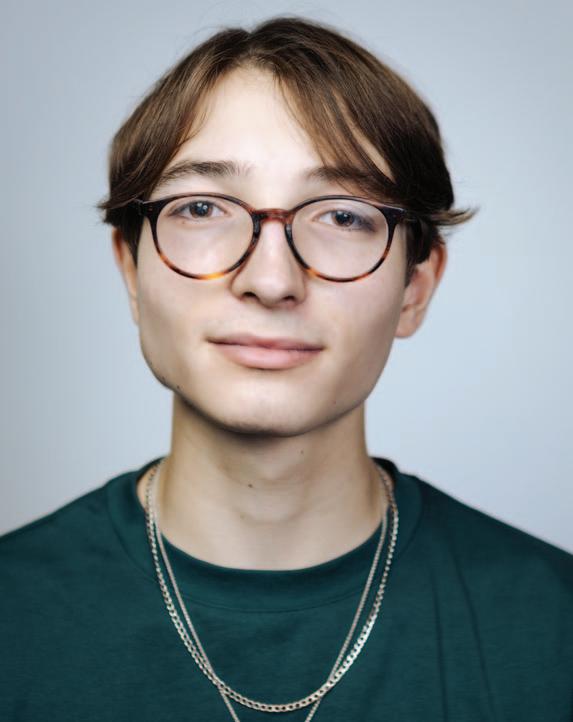
16 OCCIDENTAL MAGAZINE FALL 2022
Oliver Holoubek-Sebek
Paloma Benach
Paloma Benach was raised a Yankees fan, and her parents enrolled her in a baseball camp at 4. “I fell in love with it and I never stopped play ing,” she says.
Paloma was the lone woman on her high school baseball team in Washington, D.C., and she’s trying out for Oxy’s historically all-male squad this fall. The left-handed pitcher relies on breaking balls over speed to keep batters off balance.
“One of the ways I’ve been able to play with the guys is mental domination and mental tough ness,” says Paloma, who is considering a psychol ogy major, with a minor in neuroscience, en route to a career in sports psychology. “You should train your brain as hard as you train the rest of your body when you play a sport.”
Her father, who transitioned to female when Paloma was 11 and has coached her daughter since 2014, has played an important role as Paloma considers the world ahead. “I hope to feel as comfortable and as brave as she did with her decision,” Paloma says.
Socially and academically, Occidental defi nitely walks the talk, she adds. “It’s a kind and supportive place, and I have a new interaction with a person every day. I feel very cared for and supported here.”
Alex Romanov, 23, isn’t your typical college sophomore. He comes to Oxy having served four years in the Marine Corps, followed by a year at Santa Monica City College.
The Victorville resident transferred to Oxy on the advice of his wife’s friend, who attended Occidental and praised its close-knit community. He always intended to make a lifelong career in the military, but Alex says a budding love of writing drove him to pursue a degree in English.
A month into the semester, he calls Oxy and its pro fessors “extraordinary.” “I’m excited to be able to grow in this environment,” Alex says. He’s already secured a writ ing job at the Occidental student newspaper.
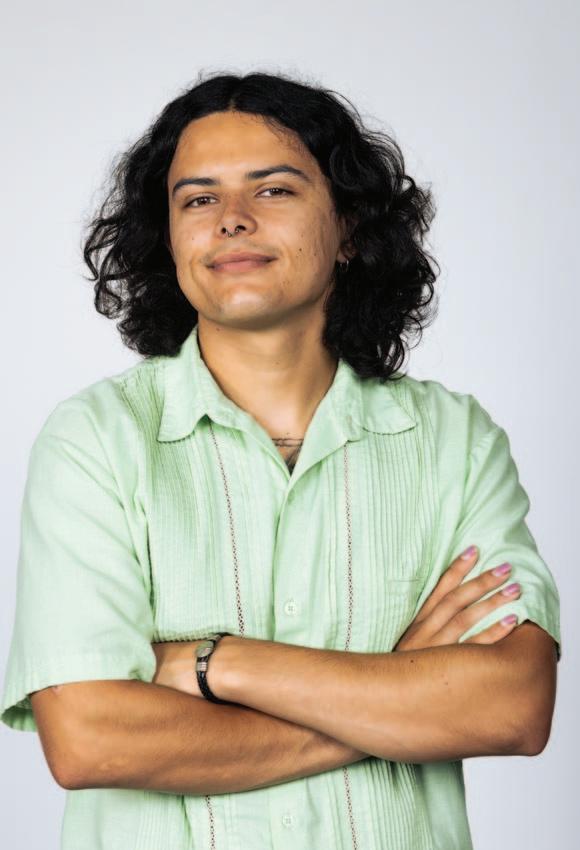
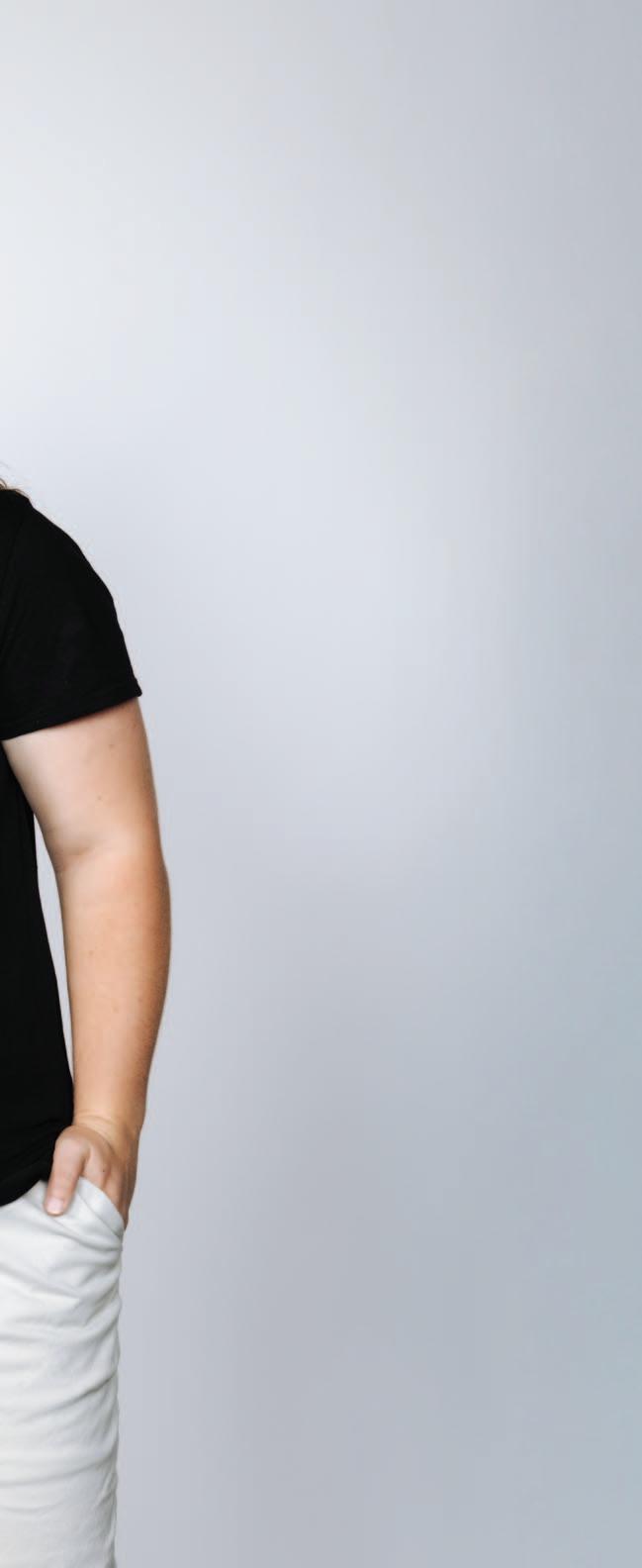
Alex “despised” writing in high school but gained a passion for the written word as a Marine, where in his downtime he read a lot, with an emphasis on genre fic tion. A particular favorite is Chuck Palahniuk, whose Fight Club is considered a classic exploration of the male psyche.
Alex hopes to one day author his own novels, or pur sue an editing career. His game plan for Eagle Rock? “I ab solutely want to learn from and capitalize on the people around me, from all these smart kids around me.”
But he also hopes to impart life experiences to his younger peers. “I bring life experience, which goes a long way,” says Alex, who lives with his wife of nearly two years, Alisha, off campus. “More traditional students are coming in from high school, and they’re still trying to figure everything out.”
FALL 2022 OCCIDENTAL MAGAZINE 17
“It’s a kind and supportive place, and I have a new interaction with a person every day.
I feel very cared for and supported here.”
Alex Romanov
MJ Jones
A shy kid growing up in Washington, D.C., Mickayla “MJ” Jones found her voice in the theater—acting in productions that included Clue, Dracula, and The Curious Savage. “My mom will talk about how my sister used to speak for me when I was younger,” MJ says. “Some how, being on the stage dissolved all of that—the shyness and want ing to stay back.”
With a passion for the arts and for quantum physics, MJ found inspiration in Merritt Moore, a quantum physicist who has danced professionally with the Zurich and Boston ballets. MJ is setting her sights high: She ultimately wants to get a doctorate in physics and become a college professor.
At Oxy, MJ plans to seek out role models to help guide her path. “Being Black and female, and being part of the LGBTQ community, it’s hard to find another person in science, let alone physics, who also meets those other categories,” she says. “But I can always find people who fit into one of those categories, and I can get support there.”
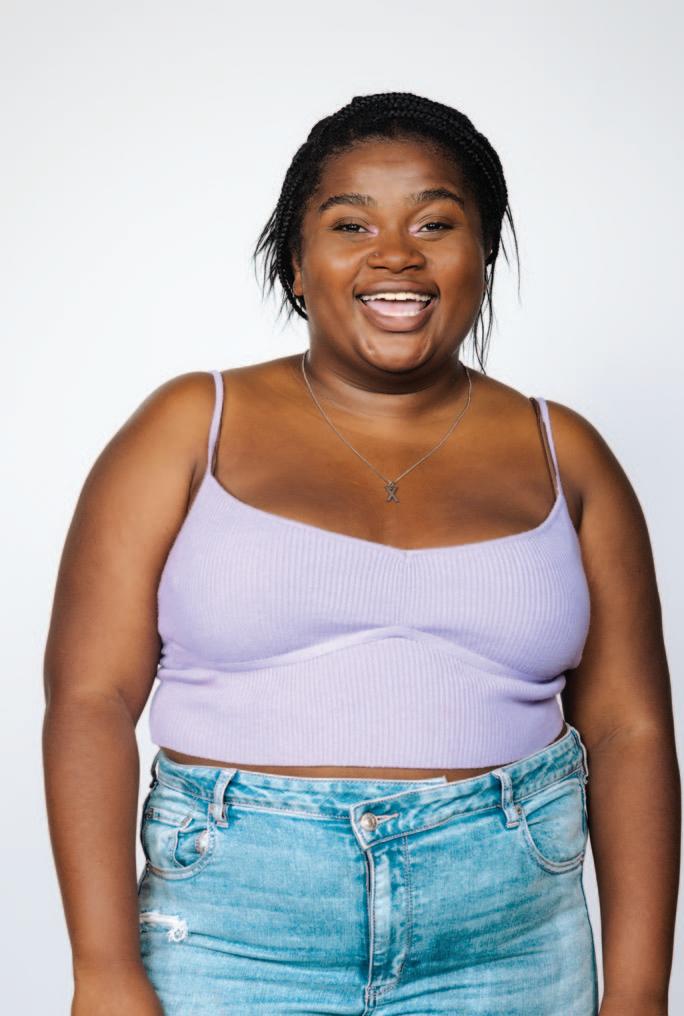
Coming from a stressful boarding school, MJ says she enrolled at Oxy for its challenging academics but also because of the laid-back Southern California ethos. She has enjoyed the friendly atmosphere, despite some early jitters. “It was weird when I got on the plane and I was like, ‘Oh, I’m not gonna come home for a bit,’ ” MJ says. “But what’s weird now is I don’t feel like my family is so far away. I can always call them, and it’s OK.”

Ethan Smith
Coming to Occidental from his hometown of Cape Elizabeth, Maine, Ethan Smith has found undeniable perks to his decision to study in Los Angeles: “There’s really good food here.”
Gustatory delights aside, Ethan is thinking about the world around him above all else. “I’m really interested in politics and social justice,” says Ethan, who’s considering a major in diplo macy and world affairs or economics. In either case, his intentions are clear. “There’s a lot of stuff going on in our government right now, and I just want to be part of the solution,” he says.
To temper the day’s stresses, Ethan turns to meditating (an interest he developed in re sponse to the “bombardment” of information from school, social media, and digital entertain ment), and he plans to swim for the Tigers this fall. He set high school swim records in Maine in the butterfly and was one of 56 swimmers na tionwide selected to attend a leadership training camp to advance diversity in the sport (he iden tifies as Latino/white). In spite of being recruited to swim by Division I schools, Smith says, “It wasn’t exactly what I was looking for in a school. It was a little too much.”
In a less political role, Ethan has worked in recent years as a line cook and server at his uncle’s lobster restaurant.
Food, it turns out, provides its own educa tion. “The main thing that working at the restau rant taught me was to be able to hold down work responsibilities while having a good time,” Ethan says. “I learned that if you screw something up, just own it and learn from it.”
18 OCCIDENTAL MAGAZINE FALL 2022
“There’s a lot of stuff going on in our government right now, and I just want to be part of the solution.”
Vivian Ko
Growing up in Alhambra, Vivian Ko mostly applied to colleges in the East, pining like many young adults for a comfortable distance from family. But in exploring her options—she was accepted to seven schools—the firstgeneration Chinese American found little across the map that could replicate the mélange of human experience at Oxy and in Los Angeles.

In the end, “I realized that I can still be independent in L.A., even though I’m so close to family,” says Vivian, the middle of three children. “I just really like the diversity in California. So many of my friends here are people of color, and I can relate to their experiences and struggles.”
Vivian is tackling her first year of college with a self-imposed man date: She’s taking classes she wouldn’t ordinarily consider. The experi ence is designed to challenge her assumptions of the world, and engage her intellectual curiosity in unexpected ways. “I’m not usually a science person, but I’m taking a zoology class,” she says. “It’s really hard, but it’s really interesting.”
Just weeks into the semester, she joined the staff of the Occidental, where her first assignment was a profile of a pair of Oxy studentathletes. Vivian, herself a competitive figure skater through high school, is considering majoring in critical theory and social justice, and might venture into journalism or education.
The College, she says, is an important partner in her journey of selfdiscovery. “I really like how Oxy encourages interdisciplinary learning,” Vivian says. “Especially in the first two years, because it allows me to take classes that just sound interesting. Maybe they will be something I would like to pursue as a major or minor one day.”
Andy Faught wrote “A Healthy Migration” in the Spring magazine.

FALL 2022 OCCIDENTAL MAGAZINE 19
A Sound Foundation
By DICK ANDERSON | Photos by MARC CAMPOS
hen Associate Professor of Music David Kasunic matriculated at Amherst, he imagined he would pursue math or diplomatic history as a major. “I was a mathlete in high school,” says the first-generation col lege graduate, who took up the piano at age 7. “I thought that music was something that was avocational, like being an actor. I didn’t have an understanding of the options that one could have in music as a profession.
“Music was just something that everyone in my family did,” adds Kasunic, who grew up in a mill town in western Pennsylvania, where his father was a steel worker. “We had stacks of sheet music—from the Beatles to Beethoven overtures—in my grandparents’ house across the street, and I learned to improve my sight reading by throwing new music on the piano. It was only in going to college that I realized what the aca demic study of music was like.”
After two postgraduate years at Amherst as a graduate associate in music and assistant conductor of the college choral society, Kasunic did

20 OCCIDENTAL MAGAZINE FALL 2022
18 17 16 15 14 13 12 11 10 9 8 7 5 4 3 2 1 6
One of the College’s oldest disciplines, music gets a makeover in response to the production boom of the 21st century—but if you want a classical education, you’ll find that as well
his master’s and Ph.D. studies in musicology at Princeton, writing his dissertation on piano music and singing in 19th-century France. Looking to the future, “I was committed to teaching at an under graduate liberal arts college,” he says. “When I interviewed at Oxy, it seemed like a place where I would be fully supported in my teach ing and my research—a place where I could thrive and grow.”
When Kasunic arrived at Oxy 14 years ago, the Music Depart ment operated much as it had for decades, graduating a handful of music majors each year (six in 2008) and fulfilling the general needs in the manner of any “liberal arts college anywhere in the country,” he says. “But the way we looked in terms of our curriculum and what we offered did not reflect our location to the extent that it could”— a sentiment shared by his department colleagues.
Fast forward to fall 2022: With 57 majors, music is now Oxy’s sixth most popular major, after economics, diplomacy and world affairs, biology, psychology, and computer science. It’s a remarkable crescendo that reflects the convergence of two movements: teen
Twenty-five of the 53 personnel in Oxy’s Music Department assembled for a photo in September. 1. Riner Scivally, classical and jazz guitar instructor. 2. César Castro, director of Son Jarocho Ensemble. 3. Michael Larco, viola instructor. 4. Jonathan Richards, bassist and director of the Occidental Jazz Ensemble. 5. Ron Berman, classical and jazz guitar instructor. 6. Allen Savedoff, bassoon instructor. 7. Dan Long, visiting instructor.

8. Simeon Pillich, resident professor. 9. Catherine Del Russo, oboe instructor. 10. Aroussiak Baltaian, violin instructor.
11. Stephen S. Hudson, assistant professor. 12. David Kasunic, associate professor and department chair. 13. Désirée LaVertu, resident director of choral and vocal activities. 14. Adam Schoenberg, associate professor. 15. Max Foreman, director of academic advising. 16. Chris Kim, Choi Family Director of Instrumental Music. 17. Fabio Paolizzo, Andrew W. Mellon Postdoctoral Fellow. 18. Junko Ueno Garrett, piano instructor. 19. Steve Gregory, rock guitar instructor. 20. Edmond Johnson, director of academic advising. 21. Celka Ojakangas, visiting assistant professor. 22. Alan Geiger, accompanist. 23. Stephen Cabell, visiting assistant professor. 24. Alexander Zhu, pro duction manager. 25. Jin-Shan Dai, violin instructor.
agers making music on their laptops, and Occidental pivoting to offer a curriculum more aligned with prospec tive students’ interests.
“They have done something pretty remarkable in a short period of time,” Charlie Cardillo, vice president for institutional advancement, says of Oxy’s music faculty. “It has so much to do with the introduction of all these dimensions of music including music business, songwrit ing, film scoring, composition, and music production— all undergirded by a true liberal arts curriculum rooted in music theory and history and culture.”
Of the 17 music majors expected to graduate next spring, 13 are in the production track—a number that in cludes aspiring audio engineers, music technologists, songwriters, and auteurs. There are also three composi tion majors and a music theory and analysis major. The Class of 2024 will have 19 seniors: seven in production, seven in composition, two in vocal performance, two in musicology, and one in instrumental performance.
As Kasunic sees it, music production is “an essential part of the wide spectrum of creative activities that constitute every thing we listen to. Anything that you hear that’s mediated—that’s not a live performance—is produced. It brings music composition and music theory together.
“In a competitive higher education landscape, Oxy will be able to offer a wholly modern, comprehensive music education that is embedded and defined by the liberal arts,” he adds. “Given the singu larity of what we can do, we believe that this will be a game changer— not just for the department but for the entire College.”
Going back nearly 100 years, Occidental’s music curriculum has strived to reflect the medium’s place in the contemporary landscape. “The establishment of a music department in 1926 paralleled the growing interest in Southern California in the arts, evidenced by the development of the Hollywood Bowl concert series and of the Los Angeles Philharmonic Orchestra,” Professor Emeritus Andrew Rolle ’43 wrote in his centennial history of the College. A music building was constructed in 1929, and five years later, a Carnegie Corporation
FALL 2022 OCCIDENTAL MAGAZINE 21
25 24 23 22 21 20 19
grant of $65,000 enabled the establishment of a library of records and musical scores.
By the early 2000s, colleges were seeing a decline in the enroll ment of students with a formal music education—such as basic music theory, or even instrumental proficiency. “A lot of that is a product of the gutting of public arts,” says Kasunic, a historical musicologist by training who teaches classes in Western music history and music appreciation.
Then, in 2004, Apple launched GarageBand, allowing anyone to experiment with making music on their laptops. “Students were coming to college increasingly engaged in creating music,” Kasunic says, “but the study of music was an alien enterprise.”
After he became department chair in 2014, Kasunic set about what he describes as a “project of reclamation of the earliest visions” for the Booth Music Quad and reimagining music for the 21st cen tury. “It was about realizing a vision for having our program look more like Los Angeles,” he says. “There was a collective will among the faculty to start having it look more like what prospective students may want to take, and also connect more to the industry around it.”
In 2014-15, Oxy added classes in music production and music business as a proof of concept, and both filled up immediately. “There were waiting lists for those classes,” Kasunic says. Conse quently, part of the department’s new approach to music instruction was making the pursuit of music production “the carrot at the end of the stick,” he adds. “That meant students would have to major in music to take some of these advanced courses. And in majoring in music, they would have to then take music theory. They would have to learn keyboard skills. We wanted Oxy to be distinct in offering music production, music business, and songwriting in the context of a liberal arts education—not as a set of skills you would take at a for-profit school or conservatory.”
Over a “breathless” two-year stretch from 2016 to 2018, Kasunic and his colleagues worked with a host of departments across the College—including Information Technology Services, Facilities, and the Center for Digital Liberal Arts—to build and roll out a full music production curriculum. Concurrent with its launch during the 2018-19 academic year, Occidental assembled a Music and MAC (Media Arts and Culture) task force to address the infrastructure needs of two of Oxy’s fastest-growing majors. (In reconvening the task




22 OCCIDENTAL MAGAZINE FALL 2022
above middle: Percussion Instructor Yuri Inoo gives a xylophone lesson to Noah Smith ’25 in Oxy’s new Percussion Studio. Tucked away underneath Thorne Hall, the space features a large ensemble space for performances and two smaller studios for lessons and practice. Four layers of drywall and acoustical wall panels ensure that percussionists can practice and perform under optimal conditions while limiting the sonic impact elsewhere. above: Associate Professor Adam Schoenberg conducts a class in the Choi Family Music Production Center computer lab.
left: Max Foreman teaches a Recording Techniques class in the Choi Family Music Production Center control room. above: Vocalist Julian Caspole ’22 lays down a track inside the recording booth.
force last year, Cardillo says, “It became clear that while there are obvious synergies between a well-supported MAC program and a well-supported music pro gram, their needs were distinct enough that we needed to tease apart those distinctions.”)
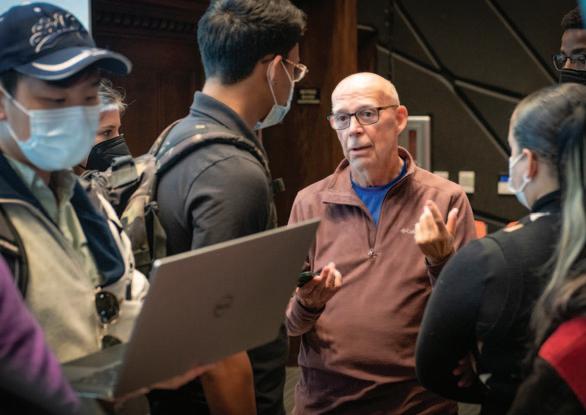
According to Kasunic, the College has fewer than half the number of practice rooms at any of its peer institutions—six on the entire campus. Offices and classrooms also double as instructional studio space, resulting in “an elaborate jigsaw puzzle that has to be figured out each semester,” he says.
In addition to “at least” doubling the number of practice rooms, a top priority for Kasunic is clustering all of them together and con verting the existing practice rooms in Booth Hall into much-needed office and studio space. “We now have five instructors having to share one office,” Kasunic says. “As we add new people, we don’t have spaces for them.
“For our department to do well, all aspects of our program have to be singing,” Kasunic continues. “In terms of running a functioning music department, we need instructional space. We need a good medium-size concert hall.” (We’ll circle back to this topic shortly.) “We need to be aspirational as well in terms of personnel through endowed positions and supporting funds.”
In addition to Kasunic, Oxy’s regular music faculty includes Asso ciate Professor Shanna Lorenz, a scholar of First Nations cultural traditions who is spending the fall semester as Vancouver Island Uni versity’s 2022 Fulbright Canada Visiting Research Chair in Indige nous Studies; Associate Professor of Composition Adam Schoenberg, an Emmy-winning and Grammy-nominated composer; and Assistant Professor Stephen S. Hudson, a music theorist whose research topics include heavy metal and R&B and soul, who joined the College this fall. The department hopes to hire a full-time, tenure-track position in music production for the 2023-24 academic year.
Of the 53 personnel in the Music Department, only 10 of those are full-time positions (another 36 teach voice or an instrument; an additional seven teach four-unit music courses). “We would like to have endowed chair positions such that the things we care about in the department—having a great composer like Adam Schoenberg, or a great director of choral music like Désirée LaVertu—are not con tingent on budget cycles or having to reapply for these positions through a hiring process,” Kasunic says. (Oxy currently has no en dowed professors in music.)
He points to other recent hires who are energizing Oxy’s music program, including Chris Kim, Choi Family Director of Instrumental Music, who joined the College in fall 2019. Over 15 years at Cornell as director of orchestras—a tenured, endowed chair—Kim built the long-neglected orchestra program into a “fully supported, well-run ning machine”—partnering with local public schools, touring inter nationally, and receiving five ASCAP Awards for Adventurous Programming.
left: More than 100 Oxy stu dents and young alumni filled Choi Auditorium on March 28 to hear (l-r) Atlantic Records
Chairman and CEO Craig R. Kallman P’25, Warner Music Group President of TV & Film & Live Theater Charlie Cohen ’78, and WMG CEO Steve Cooper ’68 discuss the music business with President Harry J. Elam, Jr. and Hameetman Career Center

Executive Director Jamila Cham bers. below: “It’s fun to go to work,” Cooper said.
Homegrown singer-songwriter Ramona Gonzalez ’09—who has released five acclaimed albums
name Nite Jewel and was named Oxy’s inaugural Johnson-Fix Professor of the Practice of Songwriting in 2018—“is a perfect example of someone who believes that being a complete human being, a complete thinker, makes you a much better artist and musician,” Kasunic says.
Leaning further into the music production space, an eight-unit course titled Music and Artificial Intelligence is being co-taught by Max Foreman, director of the Choi Family Music Production Center, and Fabio Paolizzo, Mellon postdoctoral fellow in audio engineering. Offered in conjunction with the Computer Science Department, the double course fulfills both the fine arts and mathematics/science requirements. “One thing that we have been hoping to do with the Mellon Arts & Technology grant is to create connective tissue with STEM fields, because a lot of our students have double majors in computer science or cognitive science and are very interested in those topics,” Kasunic says.
Which brings us back to the topic of space. Few would question the beauty of Booth Music Quad—a popular gathering space for cer emonies and receptions that has remained largely untouched over the last 60-plus years. But its aesthetic appeal, Kasunic suggests, has made people “blind” to the shortcomings of the space with regards to the music program. “It’s wholly inadequate for conducting music in the 21st century,” he says. Sonically speaking, “It’s porous—two teams of architects determined that we don’t have one acoustically sound wall anywhere in Booth.”
under the
FALL 2022 OCCIDENTAL MAGAZINE 23
To that end, in 2019, the department’s music library was moved from Booth Hall to the Academic Commons to make room for a new music production space designed by architect Peter Grueneisen of Santa Monica-based firm nonzero\architecture, which has designed soundstages for Sony and DreamWorks Animation as well as for twotime Academy Award-winning composer Hans Zimmer (The Lion King, Dune). The space they were given to work with was below ground level on almost 2½ sides and “was fairly self-contained,” Grueneisen told Occidental magazine last year. “From a soundproof ing standpoint, it was quite ideal.”
In fall 2021, students returned to campus to find not only the finished Choi Family Music Production Center—with a recording studio, control room, and 16-student music computer lab—but a new percussion studio in the basement of Thorne Hall as well.
Just as gifts from friends of the College facilitated the construc tion of Thorne Hall in 1938 and Booth Music & Speech Center in
our fleet of practice room pianos, teaching pianos, and performance pianos to bring them up to caliber.” (Aspirationally, Oxy seeks to join the ranks of more than 200 All-Steinway Schools globally. “It’s attainable over time,” Kasunic insists.)
Hand in hand with a plea for new or revitalized performance spaces and instruments comes a push for support of the performers. Whereas Oxy’s Glee Club—116 years old and going strong—has long enjoyed robust support from alumni, the instrumental ensembles “have been a hugely underserved aspect of our program,” Kasunic says. “We have had no endowed funds and a very meager operating budget.” (The Oxy Symphony Orchestra’s dynamic performance at President Harry J. Elam, Jr.’s Inauguration in April—in concert with the revitalized Jazz Ensemble and Glee Club, with tour de force vo cals by Lencia Kebede ’16, a diplomacy and world affairs and politics double major—should go a long way toward growing that fan base.)
Two recent instrumental acquisitions by the College speak to the ongoing depth and breadth of an Oxy music education. Using money from the Barbara U. Johnson ’43 Fund for New Music and the Mellon Arts and Technology Grant, the College purchased a state-of-the art halldorophone, an electro-acoustic string instrument modeled on the cello and made in Iceland. “We’re the first academic institution to own one in North America,” Kasunic says. (Composer and native Icelander Hildur Guðnadóttir, who won the 2019 Academy Award for her score for Joker, wrote much of the music for the film on the halldorophone.)
Schoenberg is using the halldorophone to compose a cello con certo for the Atlanta Symphony and Chorus, and a concert in Bird Studio of new music by Oxy student composers last December in cluded three pieces written for halldorophone—the first works pre miered in the United States for the instrument, Schoenberg notes.
1960, much of the department’s physical growth is contingent on engaging, if not expanding, Oxy’s donor base. “The challenge right now is to create a throughline to the past as we move into the future by having our older alumni recognize that we are not sacrificing the traditional elements of our program but expanding on them, strength ening them as we have a department that reflects more of what L.A. offers and what our students who are interested in,” Kasunic says.
Part of that narrative involves revamping and reclaiming two of the College’s premier performance spaces. With 2024 marking the 60th anniversary of Herrick Chapel and Interfaith Center, Kasunic sees an opportunity to commemorate that milestone by upgrading Herrick’s lighting and acoustics. (Grueneisen and his team produced a proposal prior to the pandemic but the project remains in limbo.)
Another project on the horizon is reopening the orchestra pit in Thorne Hall, which was closed off in the late 1990s. “The space in which the percussion studio is housed was chosen because it has the most direct access to the orchestra pit in Thorne,” Cardillo says.
Programmatically, another initiative on the horizon is to replace Oxy’s aging fleet of pianos, the average age of which is 51 (which is old in piano years). “The piano is the foundational instrument of any credible music program,” says Cardillo. “Steinway was brought in to assess our fleet, and the hope would be that we can replenish
At the opposite end of the sonic spectrum, keyboardist David Hyun-Su Kim, an expert in historically informed performance, per formed a guest recital of works by Haydn, C.P.E. Bach, and Mozart on a newly restored 1779 Buntebart square piano—a recent gift to Oxy’s historical instrument collection from trustee Gary Kaplan ’71. (The Buntebart lives behind Bird Studio, while another recent ac quisition—a new Steinway upright gifted to the College by the Choi family—is housed in the production studio.)
In October, Occidental made its third consecutive appearance on Billboard’s list of 38 top music business schools worldwide—one of only three liberal arts colleges to make the cut. Oxy “offers abundant access to internships and has developed courses such as Introduction to Music Business, where students collaborate to create artist pro files and business plans that they then execute through digital service providers such as Bandcamp and Spotify, as well as offline,” the mag azine noted.

“While I imagine that other schools down the line will look more like our department, they won’t have our location,” says Kasunic, who is passing the departmental baton to Lorenz next year concur rent with a much-needed yearlong sabbatical. “In terms of attracting personnel, internship opportunities, and visiting artists, these are the things that you get by virtue of being in Los Angeles.
“If we can get the infrastructure, the spaces, and the instruments we need,” he adds, “everything else will come.”
24 OCCIDENTAL MAGAZINE FALL 2022
Bassist Jonathan Richards, center, director of the Occidental Jazz Ensemble, with bandmates (l-r) Lucas Pan ’24, Chester Cahill ’23, Jazzbird Molina ’24, and Leslie Garcia ’24.
DIRECTOR’S
By DICK ANDERSON Photos by LEE BIOLOS

CUT

 Professor and filmmaker Broderick Fox explores the relationship between barbershops and masculinity in his new documentary, Manscaping
Fox films Shimoyama discussing his paintings at his studio in Pittsburgh.
Artist Devan Shimoyama, left, gives himself a haircut in his Pittsburgh home. Below: Fox at a screening of Manscaping at the BFI Flare festival in March 2022.
Professor and filmmaker Broderick Fox explores the relationship between barbershops and masculinity in his new documentary, Manscaping
Fox films Shimoyama discussing his paintings at his studio in Pittsburgh.
Artist Devan Shimoyama, left, gives himself a haircut in his Pittsburgh home. Below: Fox at a screening of Manscaping at the BFI Flare festival in March 2022.
above & top right: Fox traveled to Vancouver, British Columbia, to profile Jessie Anderson, who founded Big Bro’s Barbershop to serve transgender and gender-nonconform ing individuals and their allies.
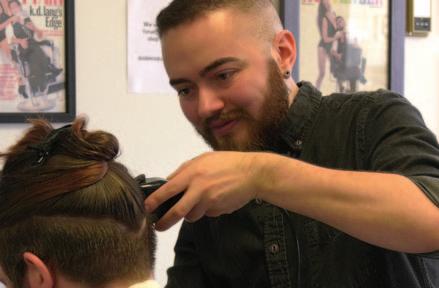

edia Arts and Culture Professor Broderick Fox did a workshop last year where he showed his stu dents how to pack all the production equipment they needed into two bags. “I basically packed like

I was going on a shoot using the equipment that they check out,” says Fox, who has made three featurelength documentaries of his own during his 18 years at Oxy. “The way that I’m producing my work in some ways is very similar to the parameters that our students are placed under. I’m literally using the same camera and editing system that they are. And the size of my crew is often smaller than the ones they’re assigned,” he adds with a laugh.
Fox’s latest documentary, Manscaping (whose tagline is “queering the barbershop”), may be his most accessi ble work to date. Since its world premiere at the Santa Fe (N.M.) Film Festival in February, the film has played at 21 festivals, including the British Film Institute’s BFI Flare festival in March and the Outfest L.A. Film Festival in July—with more to come. “Outfest was really special for bringing together current and former students,” Fox says, “even my grad school mentors and other members of the Oxy community.”
above: Richard Savvy —who bills himself as “the naked barber”— “seems like the most salacious subject on paper,” Fox says. “But ultimately, when you watch the film, he ends up being the heart of the project.”
Fox graduated from Harvard in 1996 with a degree in biology and documentary film. “I went in thinking that I wanted to be a marine biologist,” he says. “Unconsciously, I was putting together this liberal arts core experience.”
Intent on pursuing a career as a filmmaker, he went to graduate school at USC to study media production, where he was chosen to make a thesis film, which is a com petitive process. Then, he says, “Much to the horror of several of my mentors”—though many of them were quite supportive—he chose to pursue a Ph.D. in critical studies.
“Integrating history, theory, and practice has always been innate to me,” he says. “How can you think through the ethical responsibil ities or greater possibilities of creating work if you don’t look at how things have been made in the past? These are the questions that we are able to explore every day at Oxy.”
In the current digital moment, he adds, “Our students are getting more experience on so many levels. The idea of going to grad school in order to be able to be a filmmaker has changed profoundly since that time. And I think we equip our students pretty well.”
When Fox set out to make his first documentary fea ture, The Skin I’m In, he found himself at a crossroads: While he was still new in his role at Oxy as an adjunct professor of film and media studies, he had hit rock bottom personally—brought to his knees by an alcoholinduced episode that nearly cost Fox his life. “Intellectu ally and emotionally, I eschewed organized religion at an early age because of its fraught and exclusionary practices in relationship to queerness,” he recalls. “I had not yet cultivated a sense of spirit outside of myself—what we now think of more around mindfulness and things like that. But that was a really hard moment.”
Perhaps subconsciously, Fox turned to filmmaking to find meaning out of a moment of trauma—exploring how alcoholism is one reaction to a sense of being unsettled in relationship to American culture. “I was exerting a lot of self-destructive behavior onto myself, specifically onto my body,” he says. “As I was entering into my 30s, I was trying to chart a more sustainable and meaningful balance between mind, body, and spirit.
“The idea of getting a tattoo,” he explains, “was a way for me to think about how to take a body that I had done so many bleeding and damaging things to and doing something more meaningful, enduring, and beautiful.
“The nice thing about digital technology is that I could do this work without a crew,” Fox adds. “I could do it at my own pace, and I gave myself the reassurance that I never had to show any of it to anyone.” After a six-year journey, The Skin I’m In had its premiere screening on the Oxy campus in February 2012. Over the next 18 months, it enjoyed a festival run spanning 17 cities in 11 countries.
26 OCCIDENTAL MAGAZINE FALL 2022
As a filmmaker, Fox has progressed from creating an autobiographical work to turning the lens outward to tell the story of a single individual who’s addressing death and dying with a community in a more informed and grounded way (Zen and the Art of Dying, 2015) to a multiperson narrative that places three unrelated lives into conversation (Manscaping).

“I think of documentary’s potential as being inher ently queer: using intersectional and interdisciplinary frameworks to unpack perceived norms,” Fox writes in his director’s statement about the film. Manscaping “uses barbering and body hair as a means of questioning his torical and cultural ideas about masculinity and manhood in the West.”
In researching the subject, Fox contacted seven indi viduals—two barbers, two visual artists, two performing artists, and a historian—filming six of them prior to the pandemic. Once he sat down in the editing room, the material that most resonated with him was the three par ticipants who grounded themselves within the physical space of the barbershop: Richard Savvy, a fetish barber and queer activist in Sydney, Australia; transgender activist Jessie Anderson, who owns a trans-friendly barbershop in Vancouver, British Columbia; and Devan Shimoyama, an assistant professor at Carnegie Mellon University in Pittsburgh, whose paintings examine his relationship with Black barbershops.

With Manscaping, Fox says, “It’s the first time that I’ve really explored what it means to interweave multiple individuals’ experiences. I started this film in a way similar to what I challenge my students to do—to think through what the driving questions are that are gonna serve as the grounding for the project, and not to have all the answers by any stretch of the imagination.”
When Fox gets to the editing stage, Lee Biolos—his partner, producer, and sound recordist—is his first set of eyes and ears on his projects. “Lee also is an extraordinary dramaturg, having worked with playwrights and story telling in the theater for decades,” Fox says, “and we are not precious with each other around content. I also think I’ve gotten more and more adept at being honest with myself about what I have. One of the blessings of editing my own work is that by the time I say a film is done, there is no stone left unturned in the material.”
On the last day of filming with Savvy in Australia, Fox realized that something was missing. “We had gotten some amazing material of Richard doing body grooming, but I realized that I hadn’t filmed him giving a haircut,” Fox says. (Curiously enough, Fox has cut his own hair for the last two decades.)
“And so I told my partner, ‘You are getting a haircut,’ ” he continues. Like any good producer would, Biolos stepped into the barber’s chair for the camera. “Lee gets a straight razor shave in the film and has this very unex pected response where he was brought to tears through that experience.”
In completing Manscaping, Fox expanded his production team to include composer Ronit Kirchman, sound designer Scott Johnson, and Oxy’s director of digital media, Diana Keeler ’09, who did color grading and motion graphics for the film. He plans to do a screening at Oxy in the spring, around which time the film will be distributed digitally as well.

Has Fox thought about his next subject? “Every project that comes out—whether it be addiction and body issues or death and dying or questions around identity and masculinity— they’re all the queer lens that refracts all those questions for me,” he says. “But they’re all places of both interest and vulnerability, both fascina tion and fear, for me. And given the way in which I make documentaries, and the time I’m going to spend with this project or issue, is it something that is going to sustain me in terms of my own personal interest and investments?
“I think the next project that’s starting to shape up in some way is gonna be around elderhood and aging in the queer community,” Fox continues. “American culture more broadly has a fixation with youth and beauty, but there are some interesting and complex ways in queer communities in which there’s been a disconnect between generational knowledge. And I’m curious to explore what that is and possibly try to reimagine ways for that inter generational connection to occur.
“Maybe I did the films out of order,” he notes with a smile. “I should have done the aging one before I did the death one.”

above left: Fox recorded an original song, “F*ck It,” for The Skin I’m In. above right: In Zen and the Art of Dying, Fox profiles activist, educator and “death walker” Zenith Virago, who brings a commu nal engagement with death to the coastal region of Byron Bay, Australia.
above: Fox poses outside the Directors Guild of America Theater prior to Manscaping’s home town premiere at the Outfest L.A. Film Festival on July 18.

FALL 2022 OCCIDENTAL MAGAZINE 27
Outfest photo by Dick Anderson
By DICK ANDERSON Photos by MARC CAMPOS and DON MILICI
In the beginning, there was Pong. Half a century ago, Sunnyvalebased Atari Corp. launched the videogame industry with a simple table tennis game—selling more than 8,000 arcade machines by year’s end and igniting the home video craze three years later with exclusive retail partner Sears. While Pong consoles have long been consigned to eBay and landfills, the global video game market is expected to reach more than $220 billion in 2022.
It may surprise some to learn that the revenue from esports— the competitive side of gaming, which historians trace back to a Stan ford University symposium in October 1972—will exceed $1.38 billion this year. An estimated 3,600 esports professionals vie for that treasure in the United States alone, and the National Association of Collegiate Esports (NACE) counts 175 colleges and universities among its members, many of which offer scholarships for gamers.
“At this point it’s hard to tell if esports is an underdog anymore— it’s growing exponentially every year,” says Sevrin Weed ’24, a history

28 OCCIDENTAL MAGAZINE FALL 2022
With a dedicated space in the Academic Commons, a visionary team of student gamers, and a timely boost from an industry giant, esports levels up at Oxy
Oxy Gaming eboard members (standing, l-r)
Alex Prichett ’23, Lee Chico ’23, Tzu Kit Chan ’24, and Joshua Pulido ’23; (seated) Idris Smith ’24 and Sevrin Weed ’24.
left: Alexandria Nguyen ’26 and Albert Lim ’24. center: With 10 new computer stations (and an old-school TV to play some vintage video games), the Oxy Gaming Room opens weekdays at 5 p.m. right: Standing, l-r, Elise Smentek ’24, Amare Askerneese ’26, Mason Cook ’23, and Eric Stump ’24. Seated: Cor Thomas Jacobs ’25 and Prichett.

major from Minneapolis. “If you look at what kids are watching right now, they’re watch ing sports, sure. But a lot of them are also watching gamers play professionally.”
As president of Oxy Gaming, Weed is on a mission to secure a robust future for esports at Oxy. Working with the Hameetman Career Center, the offices of Student Life and Insti tutional Advancement, and an e-board packed with gaming enthusiasts, he spear headed a movement to secure a dedicated space for players to get their videogame on.
Faster than a game of Sonic Generations, the Oxy Gaming Room came together in a matter of months. And even before Room 364 of the Academic Commons officially opened in late September, “the O” (named after its primary benefactor, gaming industry giant Leo Olebe ’97) had welcomed more than 125 unique visitors.
But numbers tell only part of the story. “The hidden secret of gaming is that it isn’t about games—it’s about community,” Olebe says. “And that’s the magic. I’m willing to bet that some students will barely spend any time actually playing games when they’re in this room. They’ll be talking and finding their tribe. Gaming brings people together.”
After graduating from high school in 2018, Weed wasn’t sure if he was ready to go to college. Instead, he went to Norway to study esports. “I had really wanted to play League of Legends professionally,” he says—27 mil lion people play the game each day—“and so I wanted to throw everything I could at that to see if I can make it.” He enrolled in a nine-month program at Vefsn Folkehøgskole Toppen, where students practiced eight to nine hours daily, competed individually and as teams, and received professional coaching.
“I had planned to come back home after that,” Weed says, “but the school invited me to work there. So, I spent another year teach ing video games, which for most people my age is like living the dream.”
After COVID hit, Weed returned to Min neapolis, enrolled at Oxy (having deferred his acceptance for two years), and started his studies remotely in fall 2020. “I could have gotten a full-ride scholarship to another school off of gaming but I didn’t,” notes Weed, who coached two fledgling League of Legends club teams at the University of Wis consin-Eau Claire. “It’s partially because I believe in what Oxy stands for. Also, Oxy is located in a great spot for people who want to get into the gaming industry.”
In investigating the status of esports at the College, Weed came to know Tzu Kit Chan ’23, a philosophy and comparative stud ies and literature double major from Kuala Lumpur, Malaysia. (Dubbed “Occidental’s most involved student” in a recent newspa per article, Chan has started 16 clubs during his time at Oxy—12 of which remain active.)
“Oxy has a history of esports teams but they lacked some sort of structure or admin istration,” Chan says. In fall 2019, he sent out an email to all students to drum up in terest in a live viewing party for the world Dota 2 championships in Choi Auditorium. “I was not expecting many people to show up,” he admits—but among those who did was Deja Kirk ’21, a theater major from Nash ville. Kirk shared Chan’s interest in starting a gaming club, and the two worked in tan dem to build an e-board prior to the start of the pandemic. By the time students returned to in-person study, Kirk had graduated and “Sevrin had joined the e-board,” Chan adds.
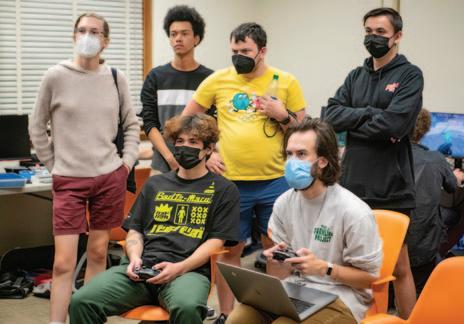
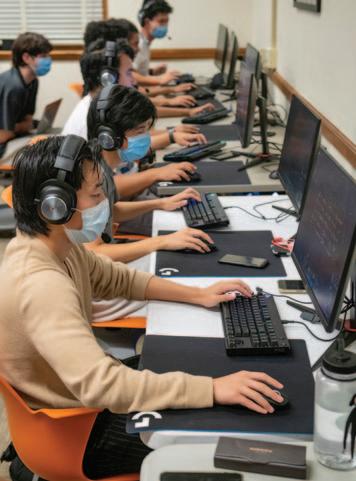
Last fall, Weed and Chan made a presen tation on esports to Vice President for Stu dent Affairs and Dean of Students Rob Flot.
With his endorsement, they looped in Char lie Cardillo, vice president for institutional advancement, and Denise Frost, senior di rector of principal and major gifts. Their ef forts culminated in a meeting with Olebe.
A double major in public policy and politics, Olebe (who served as student body presi dent his senior year) took a job after gradu ation as a management consultant in New York City and worked for New York Consult ing Partners, a McKinsey & Co. subsidiary, doing supply chain and operations consult ing. “I thought I was going to be a consultant forever,” says Olebe, who earned an MBA at USC’s Marshall School of Business, “and then somehow I wound up in games.”
Olebe has more than two decades of ex perience in the games industry working for such firms as Facebook, Disney, Electronic Arts, BioWare, and Warner Bros. He has a tattoo of Darth Vader on his arm, the by product of his five years of work on a Star Wars game. (Even his kids call him “Vader.”) After spending the last year and a half as managing director of play partnerships with Games @ Google, Olebe recently accepted a new role as global head of gaming at YouTube, where he will oversee gaming-related content and partnerships, including livestreaming.
“I’ve always been a gamer,” says Olebe, who got his entree into the business side of gaming as associate marketing manager with Disney Interactive. “Every job I’ve had for the last 23 years has been in games.”
Within 10 minutes of meeting Olebe, “We just started gushing about video games,”
FALL 2022 OCCIDENTAL MAGAZINE 29
Weed recalls with a smile. “It was funny be cause you have everybody else in the room who has no idea what we’re talking about but they’re loving it. We’re just going back and forth. The energy was there.”
“When Sevrin and I talked about what this space had to be, it had to be a space where everyone feels welcome,” adds Olebe, who served as ASOC president during his senior year at Oxy. “No matter who you are, where you’re from, or how much you play or don’t play, when you walk through that door, you’re welcome here. The No. 1 thing about the O is that it’s open for everybody.”
Olebe donated $30,000 worth of equip ment (“including 10 of the best computers you can get,” Weed says) and reached out to a contact at Logitech to procure mice, key boards, and headsets for the space.


“I think it’s amazing,” Olebe says of the O. “The students put their own twist on it, adding posters and stuff. I think we should add even more. We should add LEDs. There are so many cool ideas that you can do with a dedicated space for gaming where that community can build and grow and thrive.”
“My favorite game growing up was Super Smash Bros. Brawl,” says Alex Prichett ’23, a music production major from Baltimore. “As an eighth-grader, I was the best kid in the neighborhood, and I took a lot of pride in that.” But as he got older, he says, video games stopped being “cool”—so he focused instead on music and ran cross country: “I just got too busy for gaming.”
When he was in 11th grade, his school hosted a Smash tournament—and after a week of training, “I placed fourth out of 40
players,” Prichett recalls. “And I said, ‘OK, we’re back. I like this.’ ”
His renewed passion for gaming carried over to Oxy, where he and his roommates in Braun all played Smash (and he beat them). In time, Prichett taught them how to im prove their own skills—and he met other players on campus who were his equal, if not better. “Smash has been a really social expe rience for me, especially in college,” he says.
(As an aside, Prichett adds, Occidental has a storied history with Smash, dating back to Super Smash Bros. Melee, the second game in the Nintendo franchise. According to the SmashWiki website, Team OXY is “a crew based in SoCal founded by TheCrimsonBlur. They host tournaments such as the Kings of Cali and Super Smash Sundays series.”)
After months of running small Smash tournaments in their dorm, Prichett and his Smash pals—including Prithvi Chandra ’23, a history and international relations major from Singapore; Benjamin Share ’23, a math major from San Francisco; and Jordan Jung, a computer science and music double major from Oakland—wanted to do something big ger. “Oxy Gaming didn’t exist as an entity yet,” Prichett says. Consequently, they hosted
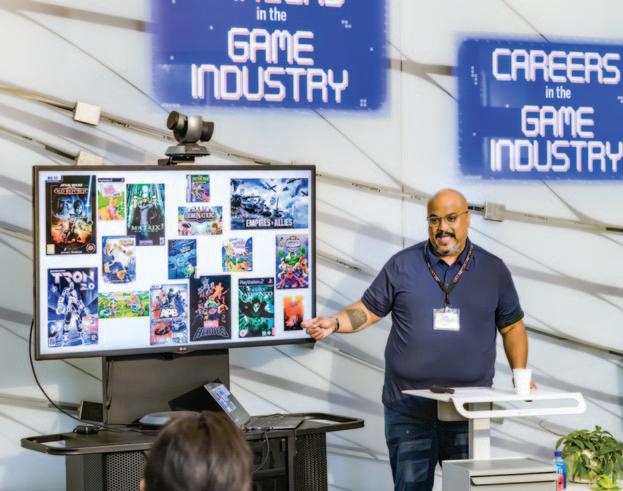
far left: Trustee Leo Olebe ’97 gave the keynote address at a gaming industry career panel held October 14 at the McKinnon Atrium inside Johnson Hall. left: Olebe puts his Apex Legends skills to the test in a 1v1 competition with Idris Smith ’24, foreground
a President’s Day tournament on the first floor of Johnson Student Center in February 2020, attracting an impressive 40 entrants. (Prichett, incidentally, finished second that day, losing to Jay Choi ’22, an English and philosophy double major from Burbank, who retired from Smash during the pandemic.)
After Oxy transitioned to remote learn ing, Prichett and his Braun buddies kept in touch through their Twitch channel. They ran 13 weekly tournaments during the early months of COVID, with Prichett livestream ing the competitions from his Baltimore home. “Benja, Prithvi, Jordan, and some other friends would hop on the stream and we’d play Smash,” he says. “That was our way of keeping this sense of community alive.”
Last fall, with everyone back on campus, the College’s two gaming groups continued to build on their COVID-fueled momentum. While the Oxy Gaming Guild was meeting with administrators and Olebe and working to secure a home for the gaming room, Oxy Smash resumed hosting monthly in-person tournaments, attracting 42 players to its first event. “We have a consistent group of 20 to 25 players who are really active on our Dis cord channels—really contributing members of the community,” Prichett says. “But there are so many people at Oxy who have at least some amount of interest in the game. And the challenge is reaching out to them.”
Smash player Lee Chico ’23, a computer science major from Los Angeles, served as an intermediary between the Oxy Gaming Guild and Oxy Smash communities. “Lee reached out to me at the end of one of our tourna ments last year with a proposition,” Prichett recalls. “I said, ‘Dude, hit me with it.’ And he said, ‘I think we should do a merger with Oxy Gaming Guild.’ I met with Sevrin about the new space. I loved his ideas and his passion for Oxy Gaming, and I’m really happy to work more on the space with him.”
30 OCCIDENTAL MAGAZINE FALL 2022
Following a seminar of alumni professionals in the gaming industry including Leo Olebe ’97, Hollie Downs ’99, Octavio Herrera ’98, Joshua Lu ’09, Alice Martinez ’08, and YouTube’s Kendra Johnson, participants celebrated the opening of the new Oxy Gaming Room on October 14.

Thanks to Weed’s and Chan’s efforts, Oxy Gaming (the word Guild has been dropped) was elevated to club sports status, “which is essential for allowing us to fund and support individual players and teams,” says Weed. In meeting with Prichett and his Smash mates following the groups’ merger over the sum mer, he recalls, “The big thing that I told them is: Go to tournaments, get Oxy’s name out there, and we will find a way to fund you. We’ll pay for the entries and see if we can cover gas. We’ll get you apparel so that you can represent us. Play the game and get the practices going—we can handle the rest.”
“It’s kind of crazy to think that we’ve been going underground basically for three years, not even a club,” Prichett says. “Now we’ve got this space and these resources, and it almost feels like the work we’ve been put ting in to create a community now has room to grow. It’s really exciting.”
While Prichett and Weed bring their prowess in Smash and League of Legends, respectively, to the club, “We’re here to support any games that groups want to play,” Weed says. “Imagine if you had football, soccer, hockey, and baseball all in one club. It would be presumptuous of us to decide we want to do just certain videogames because those are the ones that we like.”
There are other perks to the club as well: Last November, a number of Oxy gamers attended the red-carpet premiere of the Net flix series Arcane, adapted from Riot Games’ massively popular League of Legends, at Riot’s headquarters in Los Angeles. “A bunch
of gamer celebrities were there—it was in credible,” Weed recalls. “It’s only because we are located in L.A. that we could do that.”
Over a five-day stretch in July, when he was confined to his room with COVID, Prichett created a club league with other schools in Southern California—called, fittingly, the SoCal Collegiate Smash Ultimate League. “We had a Discord server set up toward the end of last year where people were sending out feelers wanting to get this done,” Share explains. “Nobody had really taken the ini tiative to set it up officially, so Alex was that guy.” (“Alex is really well connected with the Smash scene in SoCal,” Chandra adds.) With 12 schools on board, league play was expected to begin this fall.
Looking to Oxy Gaming’s future, “I want to see people hosting Smash tournaments and playing Smash with each other, or Multi Versus or whatever’s the new game where this community moves,” Prichett says. “As long as people are hosting tournaments and there’s an opportunity for gamers to meet each other in that setting, then I’ll be satis fied with what I did.”
“I think the establishment of the room in the library where we can set up base for Oxy gaming is a big step in the right direction,” adds Chandra, who is participating in the Kahane United Nations Program this fall. “One of the main issues with sustaining a club is having that space that is yours.”
“Going forward, my dream here is to have a thriving and competitively viable col
lection of teams,” Weed says. “We can also be a hub for gaming in the community so that people who are growing up nearby can expe rience that and say, ‘I want to go to Oxy.’ ”
Collectively, the e-board hopes that the O will open doors to a more diverse demo graphic. “Smash itself has historically been a male-dominated space,” Chandra says. “We are working against the game’s own reputa tion and that of video games in general in try ing to improve the atmosphere of the places where we play. That’s really important.”
“For the last five or six months, I’ve been treating Smash more as a skill—like if you were trying to be a professional musician at an instrument,” Prichett says. “I try to get in two to three hours a day of serious practice, which obviously is harder during the school year. I also travel to tournaments, where I have made a lot of friends—that’s been a really positive experience. If I ever stop lik ing it, I’ll just quit. But it is fun for now.”
As a student, “I didn’t spend enough time in the library at all,” Olebe admits with a laugh. “People have all sorts of weird regrets about their college experiences. For me, it was that I didn’t spend enough time studying. I was in every club. I was involved in everything. If I was in the library, I was probably volunteer ing for something versus actually studying.”
With the opening of the O, Olebe now has plenty of reasons to come back. “One hundred percent. I’ll be here all the time,” he says. “Now it’s time to go destroy some kids in Apex.”
FALL 2022 OCCIDENTAL MAGAZINE 31

32 OCCIDENTAL MAGAZINE FALL 2022 OXYTALK
Lisa H. Link P’18, photographed in front of Hinchliffe Hall—the Swan Hall addition completed in 2016 and named for her parents.
Photos by Kevin Burke (page 32) and Marc Campos (page 33)
Generation Next
In her sixth year as an Oxy trustee, Lisa Hinchliffe

on: increasing engagement, increasing the diversity of our board in all aspects, and in creasing our understanding of the issues that our students, faculty, and staff face, so that the decisions we make as a board are the best decisions possible.”
Link also intends to press ahead with The Oxy Campaign For Good, the College’s comprehensive campaign that surpassed its initial $225 million goal with a full year re maining. “One thing we learned from the campaign is that there is substantial alumni and outside support for Occidental and its mission, and that we can achieve even more than we already have,” she says. “The cam paign is just the first step in terms of growing our engagement, our endowment, and sup port for our students and academic pro grams.”
A Latin American studies major at Wellesley, Link completed a J.D. at the USC Gould School of Law in 1987. She practiced labor and employment law for two decades with the Los Angeles office of BakerHostetler. While with the firm, she also served for two years as an adjunct assistant professor, asso ciate director of legal writing and advocacy, and moot court faculty adviser at Gould.
Lisa H. Link P’18 has deep ties to Occidental: Her parents, Stephen Hinchliffe ’55 and Ann (Hoffmann) Hinchliffe ’57, met as students at Oxy. She also has two aunts, an uncle, a brother, and a niece who attended the Col lege. And after the younger of her two sons, Ryan, enrolled at Oxy with the Class of 2018 (her firstborn, Andy, graduated from Clare mont McKenna in 2014), Link took on a vol unteer role on the Parents Council, which proved to be a stepping stone to trusteeship.
Reflecting her parents’ long Occidental legacy, Link—a 1982 graduate of Wellesley College—grew up in the midst of their exten sive circle of Oxy friends. So, when she joined the Occidental Board of Trustees in 2016, she needed no introduction to some of the board’s senior members. “I already knew a number of trustees and trustees emeriti— people like John Power ’58, Rary Simmons ’53, and Ginny Cushman ’55,” says Link, a retired labor and employment attorney who now is the board’s new chair.
Link—whose passion for education and expertise in public school financing led her to take a leadership role in the San Marino Unified School District Board of Education succeeds Stephen Rountree ’71, who com pleted a three-year term as chair June 30.
During her six years as a trustee, Link has repeatedly played a prominent role in navi gating the future of Occidental. She was a member of the search committee that brought President Harry J. Elam, Jr. to cam pus in 2020, served as vice chair of the board’s Executive Committee, and particu larly enjoyed chairing the Student Life and Enrollment Management Committee, given her interest in the student experience and in promoting student success.
“I am excited to work closely with Presi dent Elam and my fellow trustees to support the mission and goals of the College,” says Link, who lives in San Marino with her hus band, Dave. “I will continue to work on those key initiatives my predecessors have worked
As a result of her representation of the Los Angeles Unified School District on a case involving public school financing, she was asked to co-author a white paper on that subject for San Marino Unified, where her two sons were enrolled. That led to her being asked to run for school board in 2011, where she served two consecutive terms and twice served as board president. She also served as president of the San Marino High School PTSA and the nonprofit Partnership for Awareness, as well as on the board of the San Marino Schools Foundation.
Being an Oxy parent while having gone to another small liberal arts college does give Link a different perspective from most of her predecessors as board chair, “and every now and then it’s good to have that perspective,” she says.
At the same time, Link is part of Occi dental history: In her new role, she follows in the footsteps of her father, who chaired the board from 1992 to 1994 and was named chair emeritus in 2016. “Oxy has made such a positive difference in the lives of my family and friends,” she says, “and I look forward to continuing their legacy of leadership and support of the College.”
FALL 2022 OCCIDENTAL MAGAZINE 33
OXYTALK
Link presents son Ryan ’18 with his Oxy diploma as then-President Jonathan Veitch looks on.
Link P’18 steps up to become board chair— 30 years after her father assumed the same role
The Places Jack Built
When Jack Samuelson ’46 was awarded an honorary doctorate from Occidental in 1997—half a century after belatedly completing his degree in mathematics follow ing World War II—he had a very exacting vision for what his Commencement robe should look like. “Consistent with the desire for special design details in any work that I do, I had expectations for the robe of a Doctor of Sci ence—I wanted orange piping on each sleeve,” he wrote in his 2003 memoir, The House That Jack Built. He had “a heck of a time” finding someone to make it, until his favorite seamstress, daughter Lisa, “came to the rescue —and she did it so well that the doctors on the faculty at Occidental were envious!”
above left: Emeritus Professor Bob Winter, left, reads a citation at Oxy’s Commencement exercises in 1997, when Samuelson was awarded an honorary doctorate. above right: Sally and Jack Samuelson smile for the cellphone camera wielded by trustee Dave Berkus ’62. To their left is J.R. Louf bourrow, director of development at Mount Hermon Association (one of the couple’s many philanthropic efforts). left: A confi dent young builder in the 1940s.



The Samuelson touch echoes throughout the Oxy campus, perhaps nowhere more than in the alumni cen ter named for him and wife Sally Reid Samuelson ’48. Built on the former site of the Omega Kappa Chapter of Phi Gamma Delta fraternity house, opposite the main entrance to the College, the building brims with details sprung from his imagination, from the playful tile that accents the countertops and chairs to the twin tigers etched into the glass double doors at the front entrance. “We built it to last 100 years,” Samuelson said at the Samuelson Alumni Center’s dedication on April 20, 2012.
Samuelson nearly lived to see his own cententary, dying July 17, 2022, at age 97. A native of Los Angeles, he enrolled at Oxy after graduating from Hollywood High School. “Out of my dreams, I walked through the ornamental gates onto a beautiful campus in September 1942, and began what would become a lifetime love affair with this wonderful college of the West,” he wrote in 2012. “It was here I came to study math, physics, and economics; but more importantly, I also came to under stand and appreciate the student honor code, delve into ethics, philosophy, and Judeo-Christian theology, and develop an appreciation of the arts.”
34 OCCIDENTAL MAGAZINE FALL 2022
Photos by Don Milici (Commencement) and Marc Campos (Samuelson Center)
OXYTALK
Perpetuating the architectural legacy of Myron Hunt’s master plan for campus, Jack Samuelson ’46 brought his own flair to more than two dozen projects at Oxy
His studies were interrupted in August 1944, when he attended Naval Officers Training School at Cornell University. He reported to the USS Louisville as a gunnery officer in January 1945, completing his service 18 months later. Returning to Oxy in the fall of 1946, he met his future wife, Sally, in a philosophy class taught by Cyril Gloyn ’27. (The couple was married for nearly 72 years at the time of her death in 2020.)
In 1946, Jack and his younger brother, Bob, founded Samuelson Brothers (known today as Samuelson Part ners) to engage in general construction and commercial development. The firm worked on hundreds of projects, including office buildings, schools, churches, shopping centers, manufacturing plants, athletic stadiums, and residential communities in California and Arizona.
On the Oxy campus, Samuelson was instrumental in more than two dozen construction projects, including the building of Booth Hall, Herrick Memorial Chapel and In terfaith Center, Rush Gymnasium, the Arthur G. Coons Administrative Center, Keck Theater, Mullin Family Studio and Art Gallery, and Samuelson Alumni Center, as well as renovations to a host of Myron Hunt-designed build ings, including Johnson, Norris, Weingart, and Thorne halls, Johnson Student Center, and Samuelson Pavilion. (Samuelson’s last building project for Oxy, a veterans housing complex near campus, was completed in 2019.)
The conversion of the old Art Barn and Women’s Gym nasium into Samuelson Pavilion embodied Samuelson’s approach to his work. “Once again, this was a building no one thought could be successfully renovated … it was sched uled to be torn down,” Facilities Management Associate Vice President Larry Klumas wrote in 1998. “Jack’s cre ativity and building expertise saved the whole enterprise.”
Samuelson joined the Board of Trustees in 1974, chaired the Buildings and Grounds Committee for 13 years, and served as national chair of the College’s Compass for a New Century Campaign from 1992 to 1997. In addition to his honorary degree, he received the Alumni Seal Award in 1983 and the Alumnus of the Year award in 2011.
In addition to his service to Occidental, Samuelson was a past chairman of Hollywood Medical Center and YMCA of the Foothills, and past president of the La Cañada Unified School District board. He served on the boards of several nonprofit housing companies, includ ing Southern California Presbyterian Homes, Beacon Affordable Housing (which Jack and Bob co-founded), and Keystone Housing Enterprises. “His commitment to affordable housing, in particular, had profound impact,” said John Cochrane III, president and CEO of Human Good, a Glendale-based nonprofit organization providing housing, healthcare, and support services for seniors.
Jack Samuelson is survived by his children and their spouses, including Reid Samuelson ’72 and wife Joyce (Todd) ’74; Lisa (Samuelson) and husband Chuck Paugh; Laura (Samuelson) ’77 and husband Kevin Murphy ’79; and David Samuelson and wife Michelle.
SIX BY SAMUELSON: HIS OCCIDENTAL BEST

Prior to the dedication of Samuelson Alumni Center in 2012, Jack Samuelson worked with the Office of Alumni Relations on a display case for the lobby. In addition to the Samuelson Center, he chose his six favorite Oxy projects span ning more than 50 years of work for the College.
Braun Hall, built during Oxy’s 75th anniversary in 1962, was “awarded the 38th notch on the College’s ‘groundbreaking shovel,’ ” Professor Andrew Rolle ’43





Herrick Memorial Chapel and
Center was completed in 1964 after decades of planning, thanks to an estate gift from John Pierce Herrick. In 1986, when Oxy trustees voted to remove the crosses from the exterior, Samuelson was the lone dissenter. “Obviously, my vote was insignificant compared to the majority, but since then, I’ve smiled … even laughed,” he wrote in his memoir. The floor plan, he noted, “remains in the shape of a cross, indicative of the Protestant Reformation.”
Samuelson Pavilion was dedicated on April 20, 1994—the College’s 107th birthday—in what was once the Art Barn and Women’s Gyma sium.
College
“a
OXYTALK
FALL 2022 OCCIDENTAL MAGAZINE 35
Interfaith
Professor Bob Winter, writing in Myron Hunt at Occidental
(1986), called Samuelson
model of the good-natured loyalty to the project at hand that has made the Occidental College campus one of the most beautiful on Earth.”
Arthur G. Coons Administrative Center has been at the center of College life—and generations of student unrest—dating back to its dedication in May 1968. The space also marks a notable departure from the Hunt style of architecture—a bone of contention for many.
The Willis H. Booth MusicSpeech Center, completed in 1960, rounded out the northern end of the campus with space for the Speech and Music depart ments. It also was Samuelson’s first construction project for Oxy.
Rush Gymnasium expanded on the footprint to adjacent Alumni Gymna sium, next door to Taylor Pool (the newly renovated Cannon Plaza, page 7). Designed by architects Donald Neptune and Joseph Thomas, the facility (built in 1965) added more offices while bringing men’s and women’s athletics under one roof.
wrote in his centennial history of Oxy.
left: Gonzales was the first senior Western official to meet with Guinean Transition President Mamady Doumbouya in December 2021 after a military coup that toppled former President Alpha Condé. below right: Gonzales and his family visited Angkor Wat, the world’s largest religious monument, while vacationing in Cambodia.
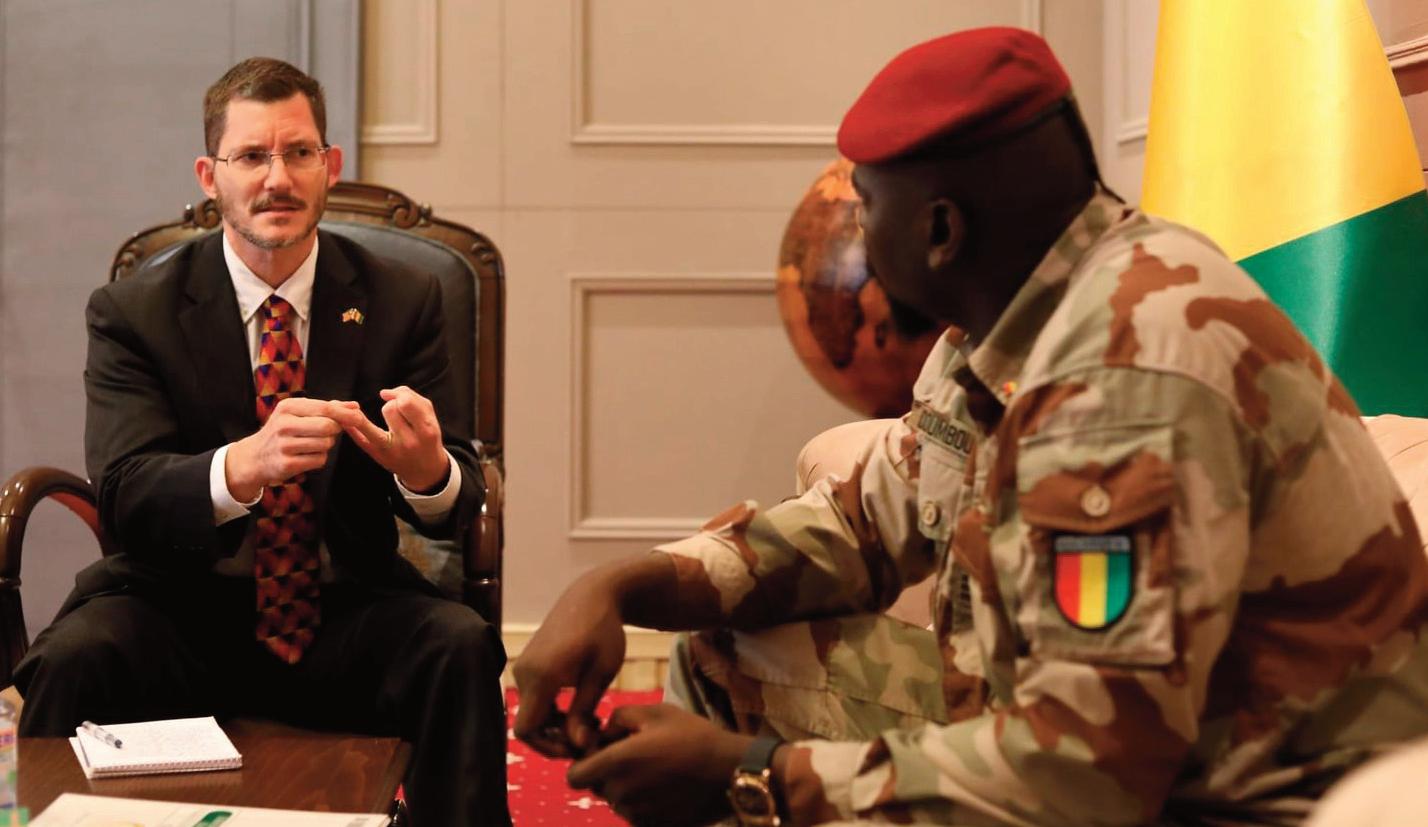
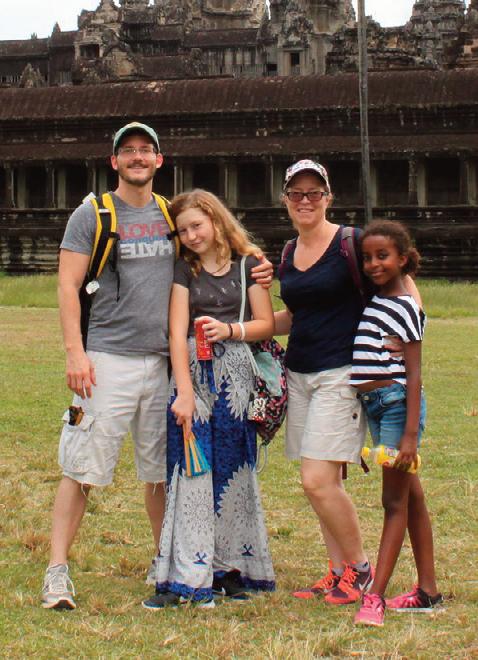
making all the right commitments in terms of democracy, accountability, and enabling environment for the private sector, Gonzales says. “These are issues I’ve spent my entire career focused on. It’s been a wonderful year watching Zambia’s renaissance, and now having the chance to go out there myself and lead the U.S. government’s contribution to it is really fantastic.”
The Art of Diplomacy
The first time Michael Gonzales ’96 set foot in Zambia, he was hitchhiking through the country en route to see ancient ruins in neigh boring Zimbabwe. Gonzales traveled to Africa thanks to Oxy’s Richter Grant program, doing independent research on education reform in Namibia. Twenty-seven years later, he was sworn in as U.S. ambassador to the Republic of Zambia on August 10, following a yearlong nomination and confirmation process.
“Many who enter the Foreign Service have the desire of one day becoming an am bassador,” says Gonzales, who majored in diplomacy and world affairs with an empha sis in African studies. “I was certainly one of those—even before I showed up at Oxy.”
Growing up in Monterey, Gonzales de veloped an interest in the global sphere early on, spending his junior year of high school living with a family in Madrid as an AFS ex change student. A first-generation college student, he participated in Oxy’s Multicul tural Summer Institute at the invitation of Arthur Saint-Aubin, professor of Spanish and French studies. “He guided me on how to make a strong argument, build out a thesis, and write really well,” Gonzales recalls.
As a participant in the Kahane United Nations Program, he interned for the secre tary of the U.N. Security Council and the Africa II Division of the Department of Political Affairs. “The oppor tunity to be in the U.N. Sec retariat and see from the inside practitioners gave me a leg up from the get-go,” says Gonzales, who served most recently in the Bureau of African Affairs, where his portfolio covered West Africa and the Sahel Region. Before that, he was the di rector for analysis of Africa in the State Department’s Bureau of Intelligence and Research. A career member of the Senior Foreign Service with the rank of ministercounselor, he previously served as deputy chief of mission and chargé d’affaires at em bassies in Nepal and Malawi.

In August 2021, Zambia opposition leader Hakainde Hichilema was elected president over incumbent Edgar Lungu with a solid majority after five failed runs. Hichilema is
Gonzales will relocate to the southern African country (population: 18.4 million) with his wife, Carol, a Foreign Service officer with the U.S. Agency for International De velopment (USAID), and their 12-year-old daughter, Hailey (older daughter Robin, 16, is attending high school stateside). There he will oversee the activities of the administra tive and executive branches of the U.S. gov ernment in-country. That includes nearly half a billion dollars in development and hu manitarian assistance that America provides to Zambia each year.
When asked what his guiding values are as a diplomat, Gonzales responds without hesitation: intelligence, integrity, and humil ity. “In order to promote and advance our
nation’s interests, one has to set aside egos and assumptions and be analytical, thought ful, and intentional,” he says. “The impor tant thing is to take the smart risks and recognize when we make mistakes, and hold ourselves and others accountable so we can learn from them and move on. Diplomacy is not at all a science—it’s very much an art.”
64 OCCIDENTAL MAGAZINE FALL 2022
PAGE 64
—laura paisley
Michael Gonzales ’96 embraces his new role as U.S. ambassador to Zambia with intelligence and integrity
Photos courtesy Michael Gonzales ’96
Snapshots from
Family & Homecoming Weekend October 21-22
1. Declaring “We Love President May” (that would be team captain Maylene Hughes ’23, center), members of the women’s basketball team show some love for President Harry J. Elam, Jr. as well. Hughes is a critical theory and social justice major from Sacramento.

2. Members of Oxy’s South Asian Students Association (SASA) held a Diwali celebration on the Academic Quad on October 21. 3. Filmmaker Michael Covino ’08 returned to campus for a screening of his 2019 Cannes prizewinner The Climb 4. From left, Alisa Margolis P’26 and daughter Lily Gotel ’26, Damarian Parker ’26, and Suzanne Saeed Tacker P’26 and son Aidan Saeed ’26 5. Barack Obama Scholars Program Distinguished Speaker Kristina Kvien ’87 (page 8) reflected on her For eign Service career in conversation with Larry Caldwell, Cecil H. and Louise Gam ble Professor in Political Science emeritus, left, and Igor Logvinenko, associate pro fessor of diplomacy and world affairs.
Your Board at Work: Supporting Oxy’s Priorities

Greetings to my fellow Oxy alumni. I am Brenda Barham Hill ’71, the new chair of the Alumni Association Board of Governors. I am also an Oxy parent, my daughter Lauren Hill having graduated in 2003. I was among the College’s first American studies majors, and the crossdisciplinary emphasis of the major made a positive impact on my professional career and personal life. My years at Oxy were transformative and occasionally tumultuous against the background of the Vietnam War, the Black Power movement, and general social unrest. Being a part of the Oxy community during this period influenced me heavily.
I enjoyed a 45-year career in higher education as an adminis trator and consultant, and my interest in and support of the College as an alumna dovetailed strongly with my professional interests. I have tried to stay close to Oxy through serving on reunion committees and attending a wide variety of alumni and College events. It was a pleasure to co-chair the Class of ’71 50-year reunion committee. Meeting remotely, we organized a robust slate of reunion activities over several months, culminating in a well-attended Zoom gathering during Alumni Reunion Weekend. Thanks to the generosity of our classmates, we raised more than $400,000 to establish the Class of ’71 Endowed Scholarship.
In my four years as a member of the Board, it’s been reward ing to work with members spanning five decades of Oxy graduates to plan and support alumni activities on your behalf. Our goal is always to encourage alumni engagement with the College through
our activities and support Oxy’s goals and priorities. Much of what we do is through three primary committees:
The Admission Committee works ▪ collaboratively with the Office of Admis sion on such activities as contacting accepted students to encourage them to attend Oxy.

The Careers and Mentorship ▪ Committee also works with Oxy staff to assist current students in networking with alumni and offers career preparation activities on campus.


The Engagement Programs ▪ Committee has responsibility for supporting a wide range of alumni programming. Their focus this year is on helping to revitalize several regional alumni groups in San Diego and Portland, Ore.
Admission

Dave Poetzinger ’89 dpoetzinger@slvusd.org Jacob Stevens ’08
Careers and Mentorship
Jackie Provost ’02 jprovost100@gmail.com Talia Robinson ’97
Engagement Programs
Steve Case ’80 scase135@outlook.com Mel Malmberg ’79 mlmalmberg@earthlink.net
I encourage you to reach out to the committee co-chairs and myself as points of contact if you would like more information and/or would like to volunteer to assist with our many activities.
Please look for columns from members of the Board of Governors in future issues of Occidental magazine. We want to stay in closer contact with you as we continue to support Oxy’s alumni and our connections to the College. Io Triumphe!
Brenda Barham Hill ’71 P’03 President, Board of Governors (b2hill48@gmail.com)
OXYFARE alumni.oxy.edu
1 2 5
Photos by Marc Campos
4 3
Office of Communications F-36
1600 Campus Road Los Angeles CA 90041-3314
Phil & Sydney Nichols’ Atypical Oxy Aria
When Phil Nichols ’68 was in ninth grade, older brother Byron ’64 arrived home to Pendleton, Ore., by Greyhound bus, ex cited to talk about his first semester at Oxy. “Our dad was the town’s Presbyterian min ister,” Phil explains, “and when my mom [Phyllis Cochran Nichols ’38] asked Byron about chapel at Oxy, he said not many stu dents went. Chapel had been mandatory when she went to Oxy, and she thought of the College as the final protected Christian environment before going out into the world. ‘Not anymore,’ Byron replied.
“That sounded great to me!” Phil ad mits with a laugh. “But I knew that going to Oxy would depend not only on being admitted but on financial aid.” He would realize his dream of attending on scholar ship, and he graduated with a degree in philosophy. Phil’s Ph.D. studies in philos ophy ended after just a few weeks when he got his draft notice.
Sydney Fox ’72 enrolled at Occidental in the fall of 1968— missing Phil by a single semester—so their Oxy romance took a slightly different path. “A mutual friend of ours from college, Hal Hansen ’71, introduced me to Phil in April 1971, a couple of months after Phil got out of the Marine Corps,” Sydney recalls. The couple were married in December 1972.
Among their common bonds was a love of music at Oxy. Phil traveled with the Glee Club on its first European tour during his freshman year, and he wishes he had sung in the Glee Club all four years at Oxy instead of just two. As for Sydney, an accomplished pianist and Oxy Orchestra member, she wishes that a faculty adviser might have encouraged her to consider whether she should have majored in music instead of Spanish literature. Still, she notes, “If I had focused on music, I probably wouldn’t have gotten an MBA.”
Phil’s desire to be a lawyer was trig gered by Bruce Bueschel, who became Oxy’s chaplain in 1968. Bueschel sug gested that Phil volunteer for the United Farm Workers and live at his house pend ing his induction (he was drafted into the Marine Corps). “It never occurred to me to go into law until I heard a UFW at torney speak,” says Phil, who—like Syd ney—did his graduate studies at UCLA.
Sydney was director of budgets for 20th Century Fox until switching to parttime consulting and volunteering as the Nichols family grew, while Phil enjoyed a long legal career working on deals for real estate capital sources.

One of his friends, trial lawyer Moses Lebovits P’04, won a large judgment in a case referred to him by Phil. As a thank you, Moses was looking for a gift for Phil, but Phil politely declined. Instead, Moses and wife DeDe—who chaired the Oxy Parents Fund while their son, Zach ’04, was a student—established the Sydney and Phillip G. Nichols Scholarship Fund in 2006.
“We have added to that fund,” Sydney says, “and the bequest in our estate plan will make this a substantial fund. It is important to us that students can enjoy the phenomenal campus, education, and growth opportunities that meant so much to us.”
In retirement, the Nichols’ life revolves around family. Their two sons and their wives and four grandchildren, ages 5 through 9, all live nearby. Phil and Sydney pick up one grandchild from school three days a week, while the others are frequent overnight guests when their parents are away. Every weekend they see their daughter Jocelynn, who lives in a home for adults with disabilities. Aria, their standard poodle, adds a spark to any gathering—and their generosity to Oxy will resonate across generations to come.
Nonprofit U.S. Postage Paid Occidental College
oxy.edu/giving
Photo courtesy Sydney (Fox) Nichols ’72
Address Service Requested



















































 By STEVEN BOYD SAUM | Photo by DENNIS DRENNER
By STEVEN BOYD SAUM | Photo by DENNIS DRENNER



































 Professor and filmmaker Broderick Fox explores the relationship between barbershops and masculinity in his new documentary, Manscaping
Fox films Shimoyama discussing his paintings at his studio in Pittsburgh.
Artist Devan Shimoyama, left, gives himself a haircut in his Pittsburgh home. Below: Fox at a screening of Manscaping at the BFI Flare festival in March 2022.
Professor and filmmaker Broderick Fox explores the relationship between barbershops and masculinity in his new documentary, Manscaping
Fox films Shimoyama discussing his paintings at his studio in Pittsburgh.
Artist Devan Shimoyama, left, gives himself a haircut in his Pittsburgh home. Below: Fox at a screening of Manscaping at the BFI Flare festival in March 2022.




































